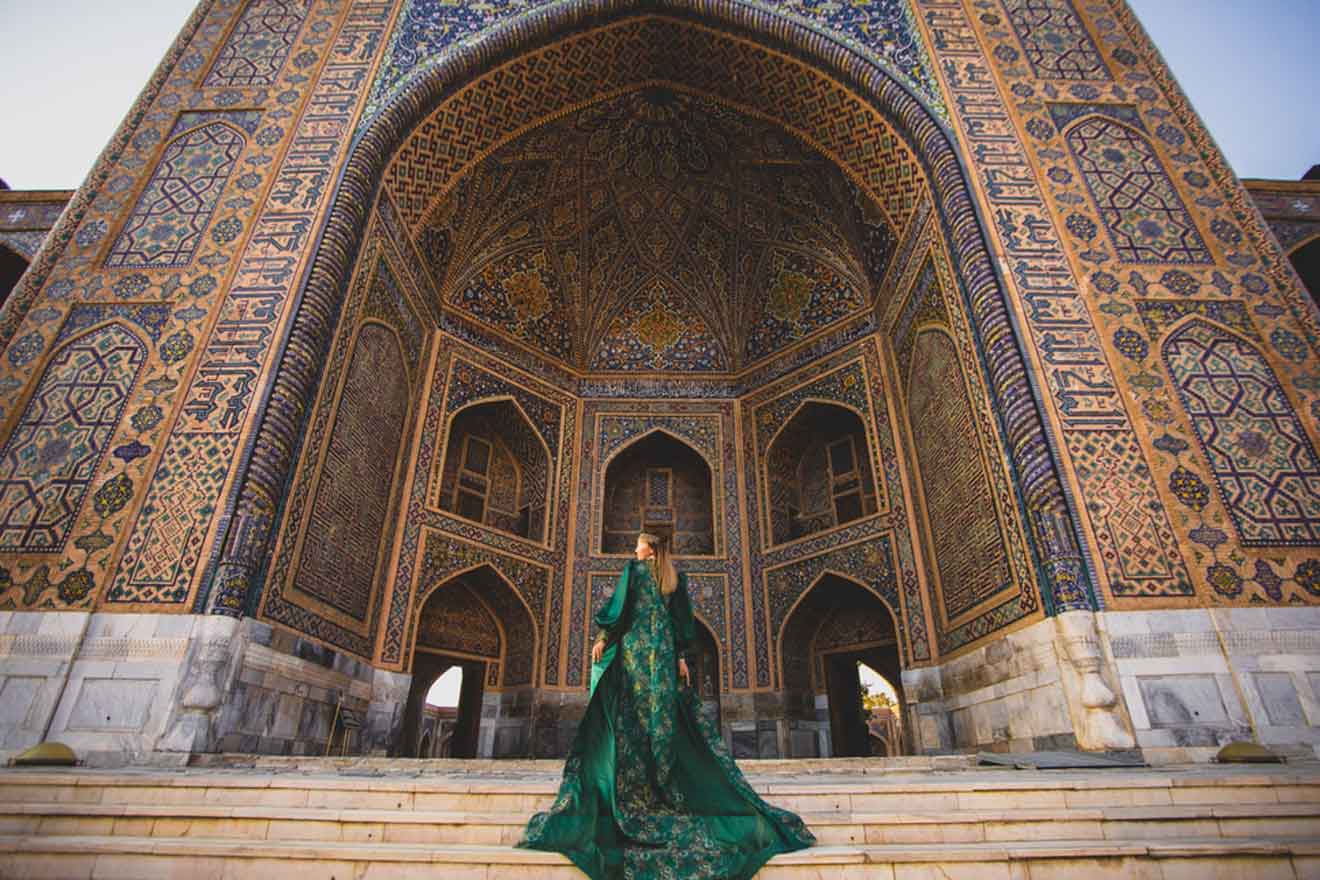
Hello adventurer, welcome to your ultimate Uzbekistan itinerary guide! I just came back from Uzbekistan and I can’t wait to share my experience with you! This beautiful yet underrated country has been under the radar for way too long, so I’m super happy you decided to visit!
In this article, I share my own itinerary for almost all the tourist cities (except one), plus I give you a few more options so you can plan a perfect 7-day or 10-day trip. From the major Silk Road cities to delicious food to the most generous people, Uzbekistan has so much to offer!
So, let’s get your trip planning started!
Quick Picks for Your Stay
Need a quick itinerary idea right away? No prob, here’s a quick summary of the article for you:
- Day 1 & 2 – Tashkent
- Day 3 & 4 – Samarkand
- Day 4 & 5 – Bukhara
- Day 5 & 6 – Khiva
- Day 7 – Urgench / Tashkent
Contents
Day 1 & 2 – Tashkent, the capital
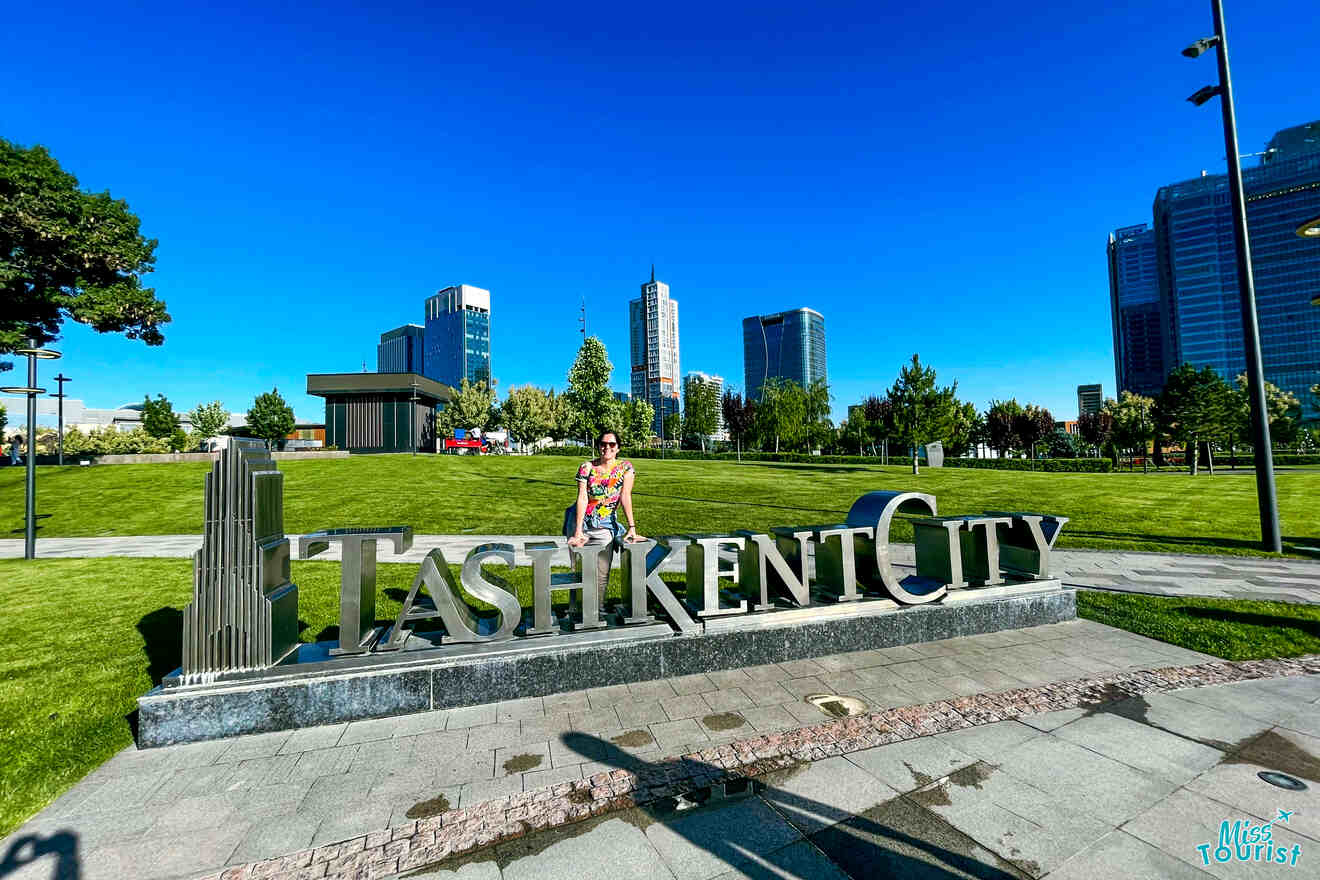
Tashkent is the capital of Uzbekistan and it’s where the main international airport is located. It’s also the Easternmost city from which most tourist visits start. After Tashkent, you slowly start to make your way toward the West of the country.
FUN FACT: Today’s Uzbekistan used to be at the very center of the Silk Road, the only trade route between China and Europe that used to operate for centuries before European explorers discovered sea trade routes.
The famous Silk Road cities of Uzbekistan make a line from the East to the West of the country. It starts from Tashkent at the very East, then stretches to Samarkand, Bukhara, and Khiva in the Northwest.
Tashkent is a huge city with a population of almost 2.5 million people. A mix of the old and mostly new, Tashkent offers a different vibe from other Silk Road places. It’s mostly similar to other Soviet-era cities like Moscow or Minsk (capital of Belarus) with its large boulevards, clean roads, plenty of parks, and gigantic buildings.
Uzbekistan used to be part of the Soviet Union from 1924 to 1991 together with Russia, Belarus, Ukraine, and 11 other countries in Europe and Central Asia, and a lot of the architecture in the country dates back to the Soviet times.
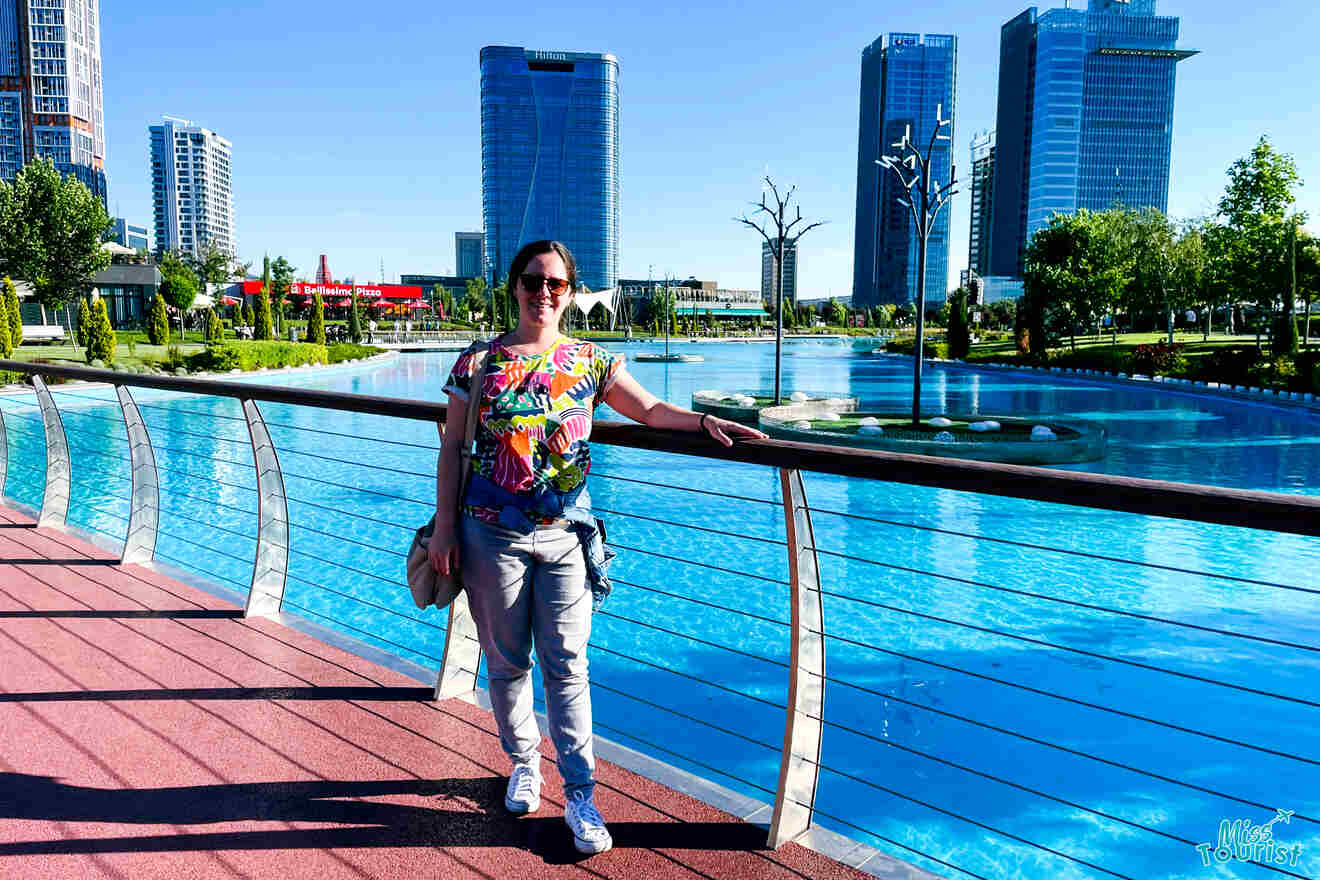
Given how huge everything is in Tashkent (it won’t be like this in other cities), make sure to give yourself enough time per attraction. The good part is that you can use the Yandex Go service to get a taxi ride that’s super cheap and efficient. We paid like $1.5 for a 20-minute ride from the airport to our hotel.
Or, you can just use the metro, it’s also cheap and even more affordable, US$0.15 per ride.
A metro ride is well worth it as Tashkent has really beautiful metro stations similar to those in Moscow (which are known to be the most beautiful in the world)!
NOTE ON UZBEKISTAN TOURS: You’ll find tour guides everywhere you go in Uzbekistan. You can get private guides to take you around on full-day tours (similar to the ones on GYG, most hotels can hook you up with one) or hire a local guide at the entrance of most attractions. The personal guide service costs around $8 for most landmarks we visited across the country.
We also saw multiple groups of French, Spanish, and American tourists who visited on organized tours from their own countries. So if this is something you’d like to try, do some quick online research to find out if local tour agencies in your country offer Uzbekistan tours.
Things to do in Tashkent
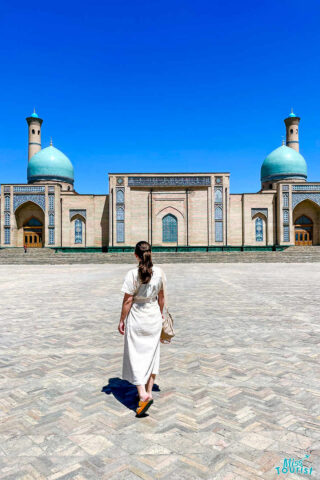
Timur Square (map) is the main square in Tashkent with beautiful gardens that continue into pedestrian streets lined with shops, bars, restaurants, and tons of attractions for kids. Timur Square is a top attraction in the city, so you can start your visit from here.
The second biggest attraction is the Chorsu Market (map), a giant indoor and outdoor market where you’ll find just about anything your heart desires, from clothes to cheese to fresh meats to ice cream to plants to products for home.
From the market, you can walk to a nearby Kukeldash madrasah (map) or take a short taxi ride to the Hazrati Imam Complex (map). This Complex hides the oldest manuscript of the Quran and is a sacred spot for Muslims! We loved the visit here, and I definitely recommend it as a stop in Tashkent.
Madrasas are middle-aged Islamic schools where young people used to get their education. They are now mostly repurposed as souvenir shops. You’ll find them across Uzbekistan.
I also recommend a visit to the Tashkent TV Tower (map) where you can climb and get a 360-view of the city. It was a nice experience that only cost us like $3 per person, which is, by the way, how much you can expect to pay to enter most tourist attractions across the country.
Also, if you’re into shopping and entertainment, head to Magic City (map)! It’s this huge open-air shopping mall with stunning decorations and themed streets that represent different parts of the world (think France, Italy, U.K., U.S., etc.).
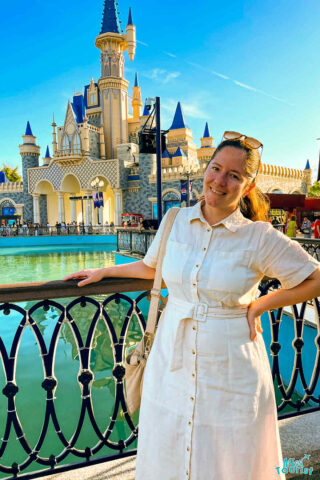
We also visited Tashkent City (map), a brand new luxury neighborhood of Tashkent 20 minutes on foot from Chorsu Market. There’s a lovely promenade along a shallow canal with kids playgrounds, cafés, shopping malls, and fun installations for taking pictures. Well worth the trip if you want to see the new, luxury face of Tashkent.
PRO TIP: To make our trip to Uzbekistan easier, I made a virtual Uzbekistan itinerary with all the points of interest using Wanderlog (a free travel planning app), and it was so useful! I could see all the attractions labeled on a map of every city we visited, so we could easily plan in which order to see things or what to prioritize. I also used Maps.me for offline navigation when walking, and it worked so much better than Google Maps. If you want to learn more about these and other free travel apps, I have a special article about the topic here!
IMPORTANT: When booking train tickets for rides across Uzbekistan, use the 12Go website. The official Uzbekistan Railways website hardly ever works for foreigners. We got all our tickets via 12Go, and it all worked out fine. Try to book the fast train (Afrosiyob), but beware that this is the first one to sell out. You should book at least 3 weeks in advance to secure a spot!
Where to eat in Tashkent
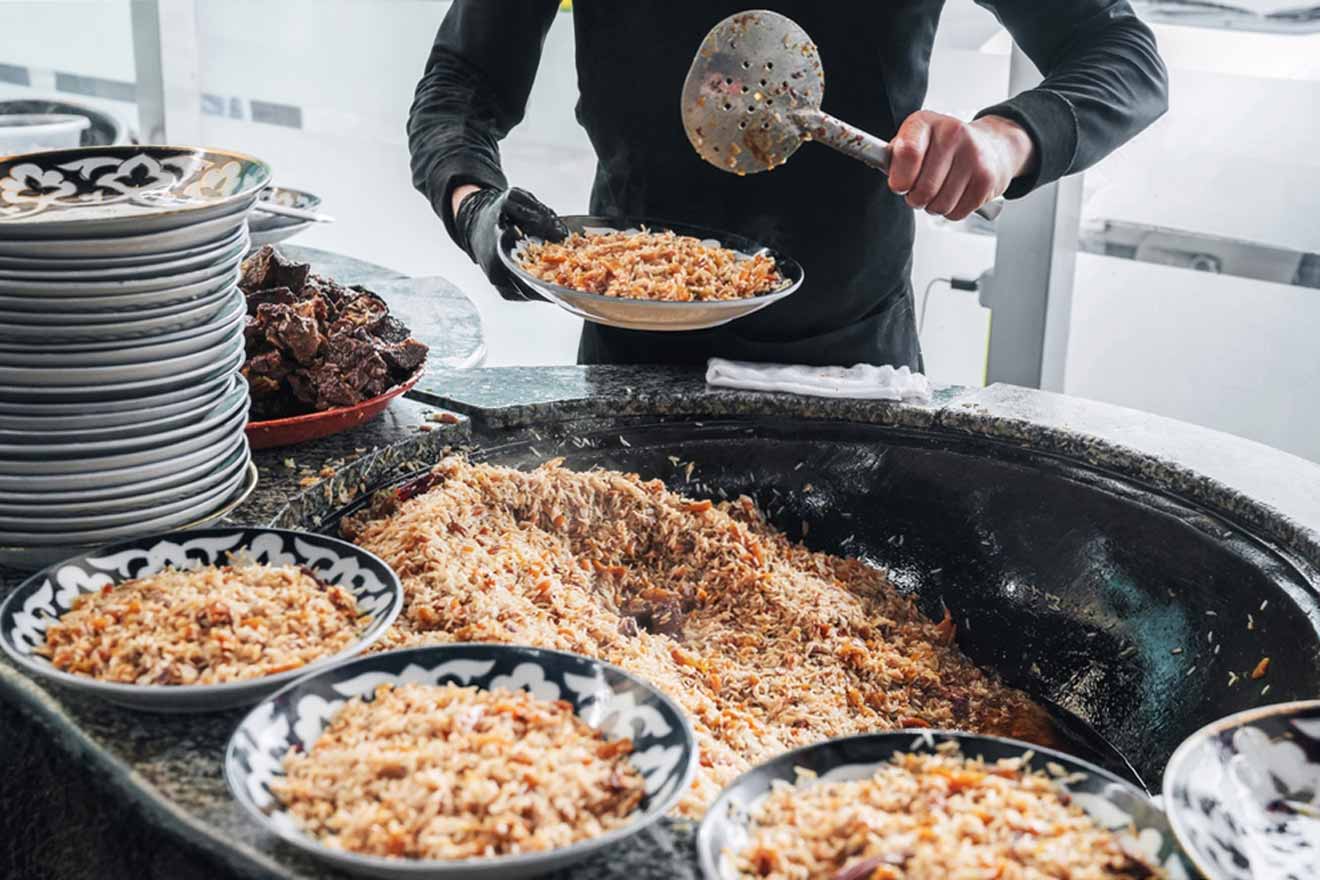
The food scene in Tashkent varies from traditional restaurants to fancy wine and cheese-tasting restaurants in the European style. Since we had only two days in Tashkent and ate breakfast at the hotel, we only visited a few restaurants, but they were all delicious.
First of all, a must-visit in Tashkent is the Plov Center (map), this gigantic restaurant that serves plov (Uzbekistan’s national dish made of rice, meat, and vegetables) in huge cauldrons. This was probably my top impression in Tashkent as the place is enormous, you get to see how they make the plov and you get to eat it together with at least 1,000 more people (the place is always crowded, but the service is pretty fast!).
Also, we accidentally discovered this Just Wine Bar (map) place that blew us away. We tried their local Uzbekistan-grown-and-made white and red dry wines, both were delicious!
I can also recommend a great place to try lagman, traditional Uzbek noodles! It’s called Lagman House (map), has various types of lagman to try, and really fast service.
Overall, a meal in an average restaurant in Tashkent costs around $10 with a drink, entrée, main dish, and dessert per person. This is a pretty good deal if you ask me!
The most expensive meal we paid for 2 people in Uzbekistan was around US$30, and this included the 15% tip (usually they automatically include it in the bill), a non-alcoholic mojito, 3 beers, 2 salads, 2 plovs, and 2 grilled meats (chicken wings and a kebab).
Where to stay in Tashkent
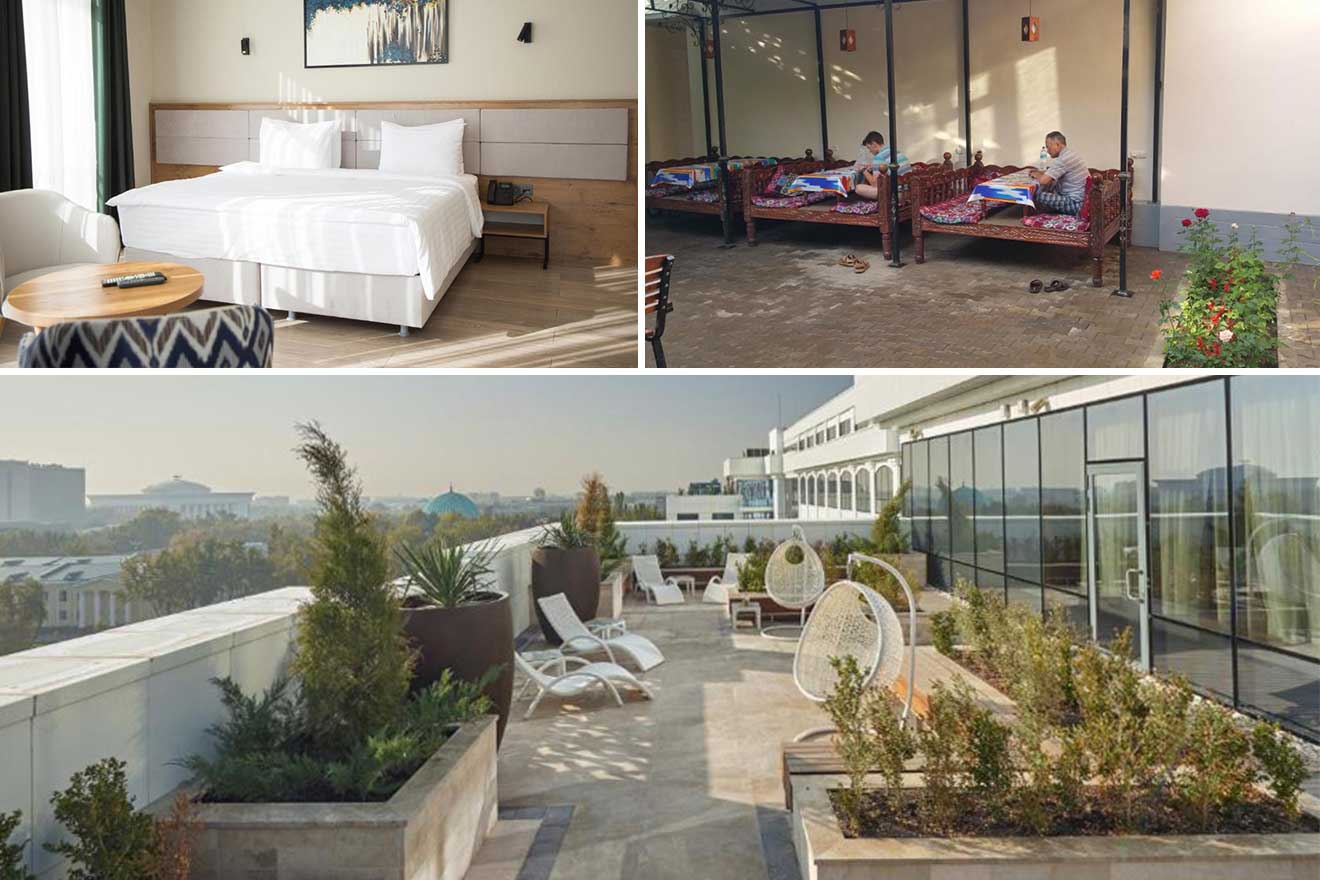
So, when choosing your hotel in Tashkent, I recommend picking a place that’s either closer to the main square in the East or Chorsu Market in the West. This way, you’ll do just a little less driving around and more walking, but either way, you’ll still rely on taxis or public transport to get to most places.
- Luxury (US$170 and up): Hyatt Regency Tashkent – a hotel like this would easily cost you over $400 per night in any European or American city, but in Tashkent, it’s less than half that! World-class service, a private spa and pool, buffet breakfast, and vicinity to the main square make this the best luxury hotel in town.
- Mid-range(US$80 – US$170): Hotel Marwa Tashkent Pool&Spa – we stayed in this hotel during our stay, and I couldn’t recommend it more; the service and location were perfect
- Budget (up to US$80): Gulnara Guesthouse – a top-rated, authentic stay in a family-run guesthouse with a complimentary breakfast
Day 3 & 4 – Samarkand, the Silk Road capital
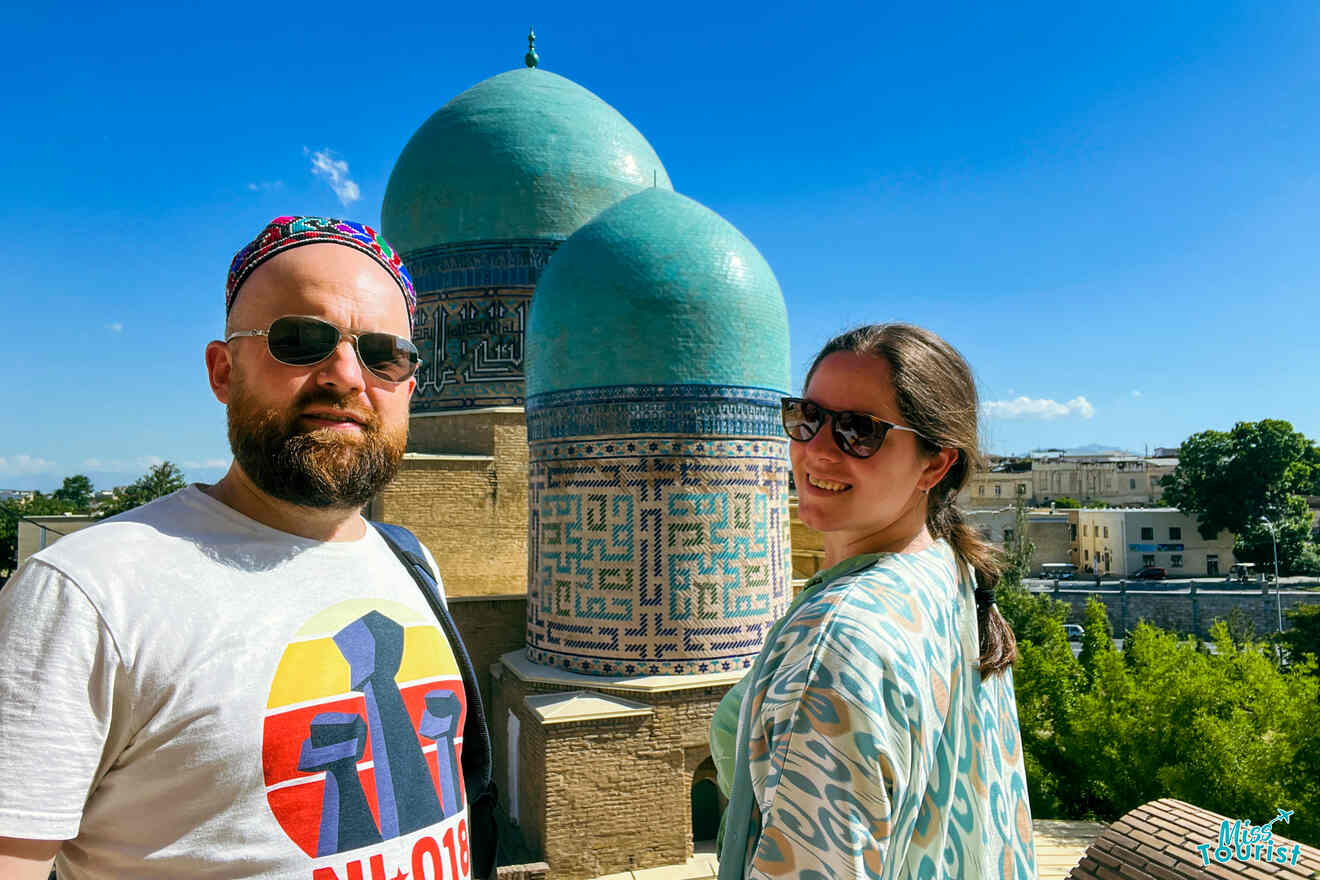
A 3-hour train ride East from Tashkent takes you to Samarkand, the magnificent Middle Age capital of the Timurid Dynasty, which ruled over Central Asia in the 15th and 16th centuries.
The Timurid dynasty, with Amir Timur as its first ruler, was renowned for the revival of intellectual and artistic life in Central Asia. Most of the stunning landmarks of Uzbekistan, with blue-tiled mosaics and geometric patterns, actually come from this period!
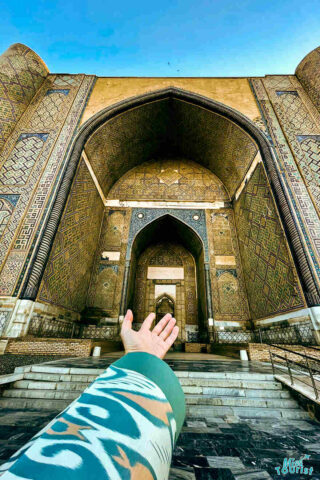
Samarkand has a very important place in the region’s history. It used to serve as the crossroads of all major Silk Road routes connecting Europe and Asia. Since all the money of the time was here, Timurid rulers could afford to splurge on stunning mosques, madrasas, temples, and buildings that look out of this world!
The Old Town of Samarkand (where most of the historic attractions are) is pedestrian-only, and it’s kind of like a unique version of Disneyland, only history-themed. It’s filled with attractions, souvenir shops, and restaurants, and there are no locals who live there. You will, however, find plenty of hotels here so you can stay in the center of all the action!
NOTE: A taxi ride from the central train station to the Old Town takes around 20 minutes, but please don’t accept a ride from taxi drivers at the station! Order one using the Yandex Go app, you’ll pay so much less!
Things to do in Samarkand
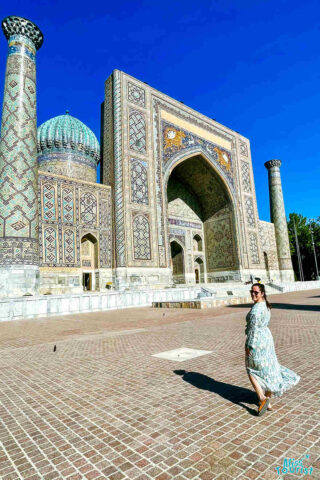
The very central square of Samarkand and the city’s biggest attraction is the Registan Square (map). Fully reconstructed and taken care of, all of the 3 buildings that surround the square are top tourist attractions.
Visit Registan Square both during the day and night! They have the cutest light projections with music at night that you can enjoy for free from the viewing platform right next to the square!
Then, the Shah-i-Zinda Necropolis (map) to the East of Old Town is probably the most Instagrammable spot in all of Uzbekistan. Weirdly enough, these are tombs of the great rulers and their families, but the intricate tile décor is so inviting and mesmerizing for the eye the tourist can’t help but take tons of pictures!
Bibi Khanum Mosque (map) is one of the most splendid examples of Islamic architecture and used to be one of the largest mosques in the world in the 15th century. It’s in the Old Town complex of attractions, so you can visit it on foot.
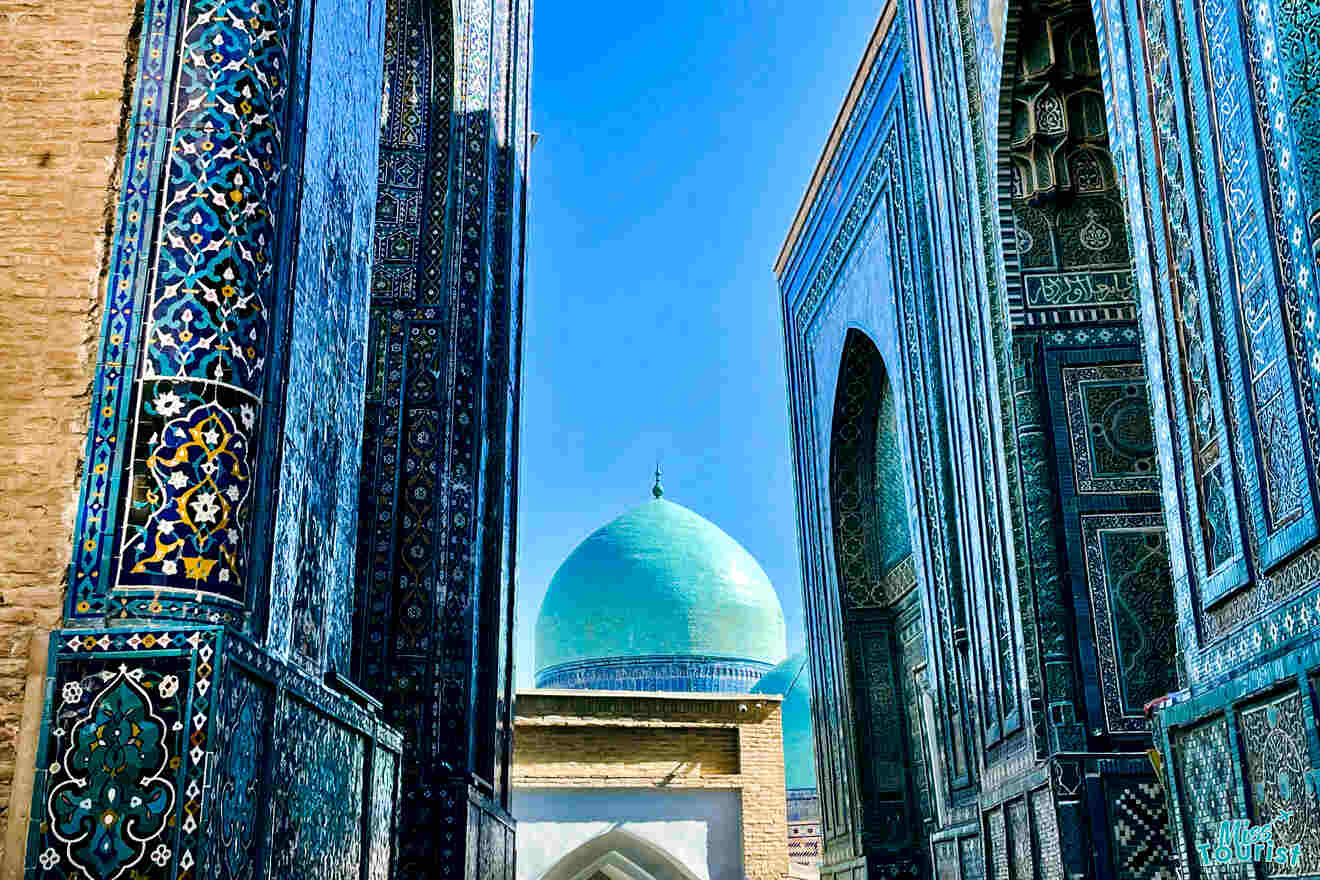
FUN FACT: The giant mosques and structures of the Middle Ages, including the Bibi Khanum Mosque, don’t have any windows. This is because of the insane heat. Uzbekistan is one of the 2 most landlocked countries in the world (it’s a landlocked country, plus it’s surrounded by landlocked countries, too), and most of its cities have a really low altitude.
As the heat tends to build up in lower altitudes, Uzbekistan’s cities can reach over 50 degrees Celsius in summer. That’s why they built windowless buildings at the time! When we visited, it was 35 degrees daily already and it was the end of May. But entering the mosques was so refreshing and cold, you can definitely tell how smart this system was!
Another must-visit is the Mausoleum of Amir Timur (map), Central Asia’s most dreaded ruler after Ghingis Khan and the founder of the Timurid dynasty.
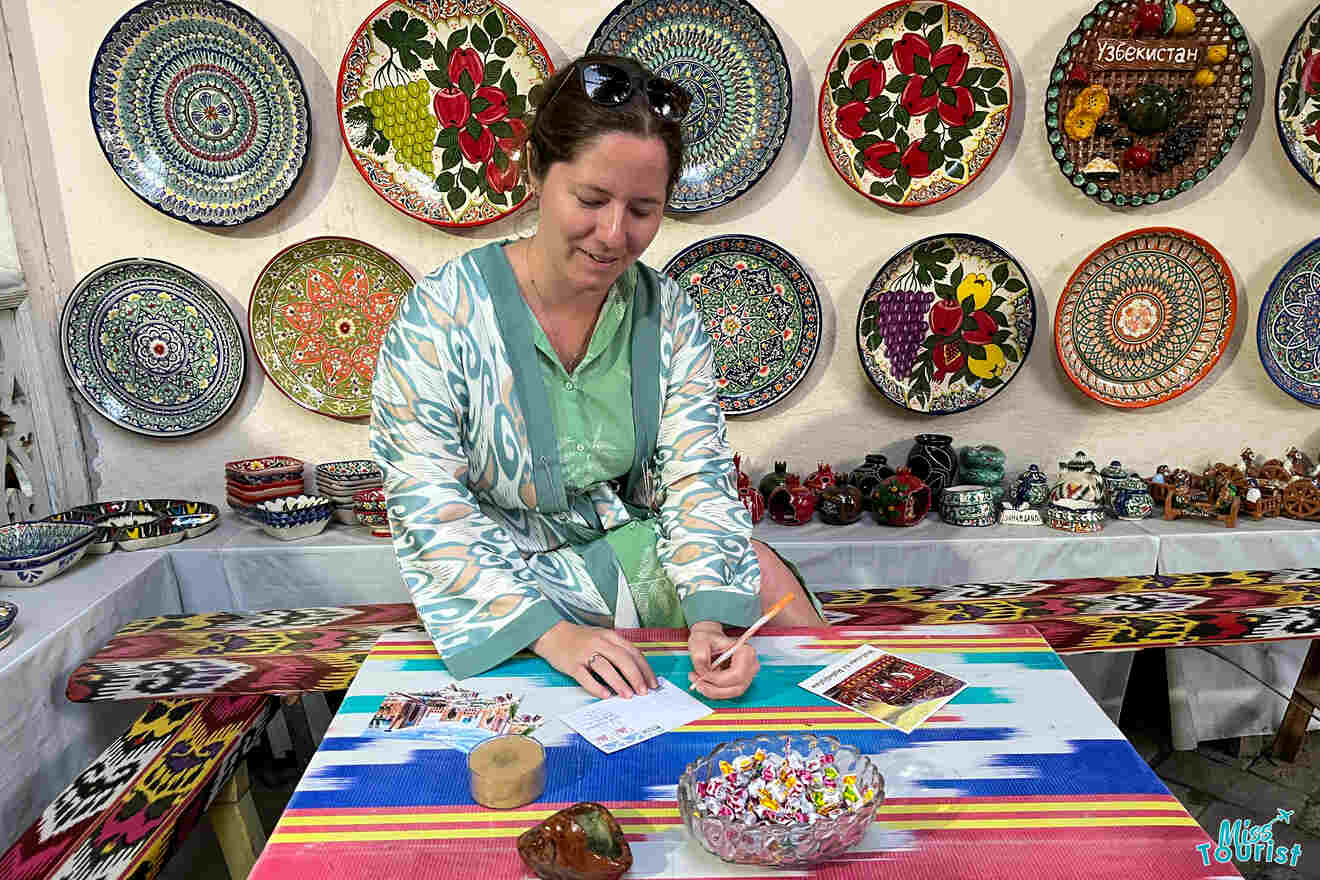
Some other attractions or popular places to see in Samarkand include:
- Siyob Market (map) just next to the Bibi Khanum Mosque, a huge market where you’ll find fresh produce, souvenirs, clothes, meats, fresh fruits, spices, and anything in between.
- Mausoleum of Islam Karimov (map), the first president of Uzbekistan; has a lovely view of Samarkand
- Tomb of the Old Testament Prophet Daniel (map) with plenty of interesting stories local guides will share with you there, including why his tomb is super long.
- Ulugbek Observatory (map) – a must-see place for astronomy enthusiasts or just anyone who wants to learn how the most celebrated Timurid astronomer calculated time, observed the stars, and spread his knowledge across the world.
The Necropolis, Prophet Daniel Tomb, and the Ulugbek Observatory are best to be visited in group by taxi, as they’re all nearby.
PRO TIP: Get an Airalo eSIM for your stay in Uzbekistan, it will make booking taxis easy wherever you are in the country! I used their 2 GB plan for my entire 10-day trip. By the way, I used the Global plan that covers all countries in the world, which is just perfect if you plan to visit more countries like I did (we also stayed in Azerbaijan). No need to switch SIM cards and waste time and money at airports!
Where to eat in Samarkand
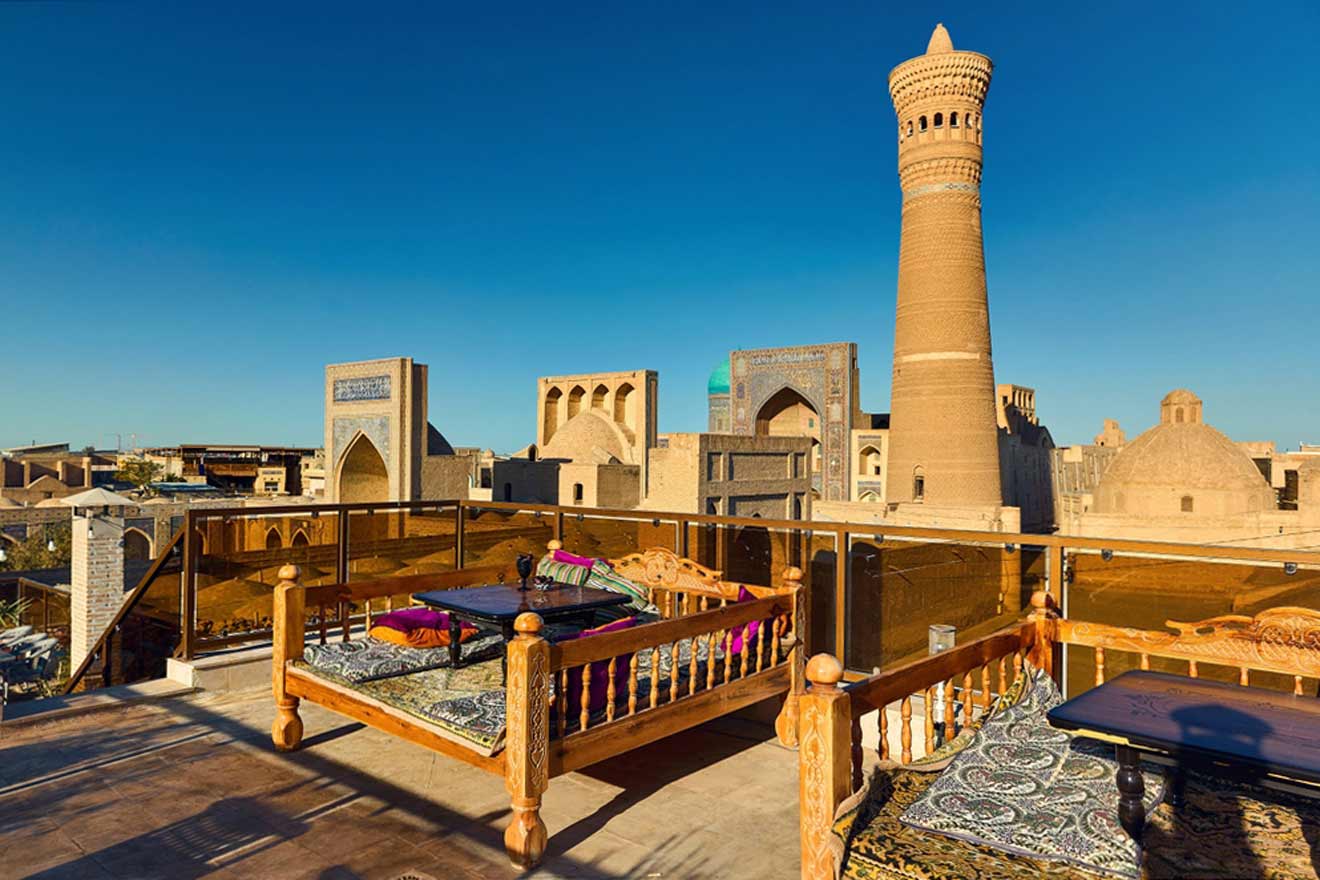
Samarkand has plenty of traditional restaurants across the Old City, but I’d only go for top-rated options that aren’t flooded with reviews calling the place a tourist trap.
We were lucky to find some amazing restaurants where the locals also eat and that have a lovely atmosphere and delicious food:
- Old Havuz by Shashlik.uz (map) – This was the best restaurant we visited in Samarkand, and if we had more time, we’d definitely come back again! Live traditional music playing every night, sitting on ottomans, delicious food, and friendly staff.
- Emirhan restaurant (map) – A fabulous 3-storey restaurant with a rooftop terrace overlooking Registan Square. They serve delicious Samarkand plov!
- Arirang (map) – Traditional Korean restaurant where you grill your own meat, super authentic and worth trying if you’re into Korean food! By the way, Uzbekistan has a large population of ethnic Koreans, so their food here is definitely authentic!
Where to stay in Samarkand
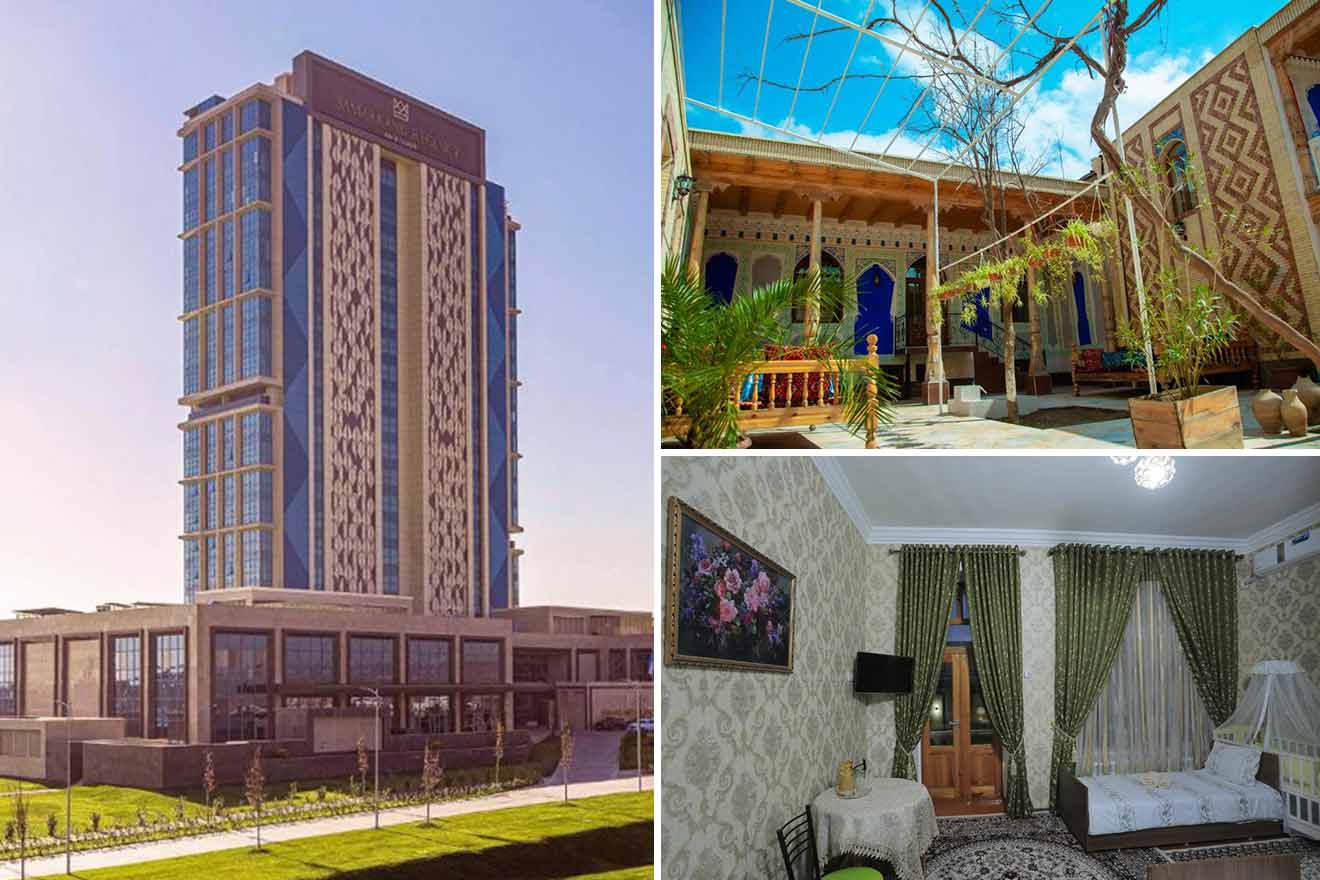
I definitely recommend booking a hotel in the old part of Samarkand so you can walk to most of the attractions. At one point, you’ll have to take a taxi to get to some further attractions of the city like the Necropolis, but you definitely want to stay as close to Registan Square as possible. It’s what we did and I’m so glad because it’s so peaceful at night with no cars at all, it almost feels like you’re staying on a remote island.
- Luxury (US$100 and up): Hilton Samarkand Regency – For luxury stays, you’ll have to pick a place outside of the old town, and Hilton Samarkand Regency is definitely the best choice. They have multiple on-site restaurants, 2 pools, a spa, wellness center, and spacious rooms that are spotlessly clean!
- Mid-range (US$50 – US$100): Bibikhanum Hotel – We stayed in this hotel, and it felt like a yoga retreat – so beautifully decorated, peaceful, and with plenty of woodwork everywhere, plus it was adjacent to Bibi Khanum mosque
- Budget (up to US$50): Royal Lux Guest House – A top-rated budget stay just a 9-minute walk from Registan, a complimentary breakfast, and a mini market on-site
Subscribe here to get up to 35% off your accommodation for your next trip!
Day 4 & 5 – Bukhara, historic heart of Uzbekistan
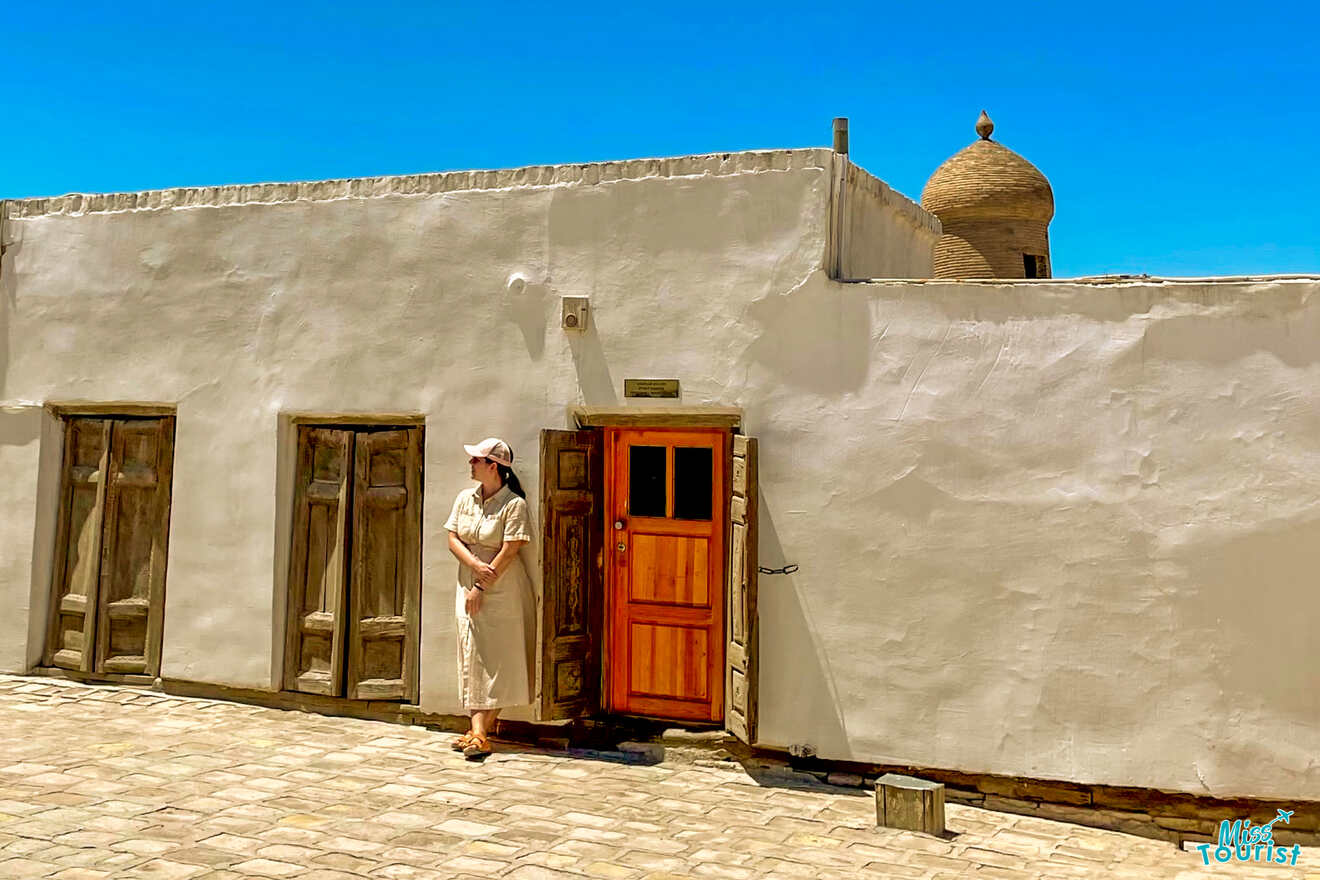
The next stop on the Silk Road adventure in Uzbekistan is Bukhara, some 270 km (167 miles) West of Samarkand. You can depart in the evening of Day 4 of your stay and take a direct train from Samarkand to Bukhara (takes around 2 and a half hours), or you could spend another night in Samarkand and take the early morning train on Day 5.
Before my trip, I knew about Tashkent and Samarkand, but had no idea about the existence of these other stunning cities, and Bukhara is the one that blew me off my feet.
Bukhara is considered one of the most important historic cities in the country, something like a living museum. I heard some guides say that Bukhara is one of Central Asia’s oldest inhabited cities.
Its most charming part is definitely the very heart of the Old Town (they call it Ichon-Qala in Uzbek) where you’ll find narrow streets with souvenir shops selling the most colorful clothes and handmade goods. Think magnificent 5,500-dollar handmade carpets, miniature paintings depicting Silk Road caravans, silver plates carved with Bukhara’s monument silhouettes, and so much more.
Just steps from these alleys is the Main Square that’s so steeped in history I don’t even know where to begin describing it. I’ll just say that when Ghingis Khan came with his army to Bukhara, he was so blown away by the beauty of its central minaret (Kalon Tower, map) that he ordered everything to be demolished except the minaret!
FUN FACT: Bukhara’s law enforcement used the tower to publicly exercise the death penalty by throwing the prisoners off of the top of the tower up until the early 20th century!
Things to do in Bukhara
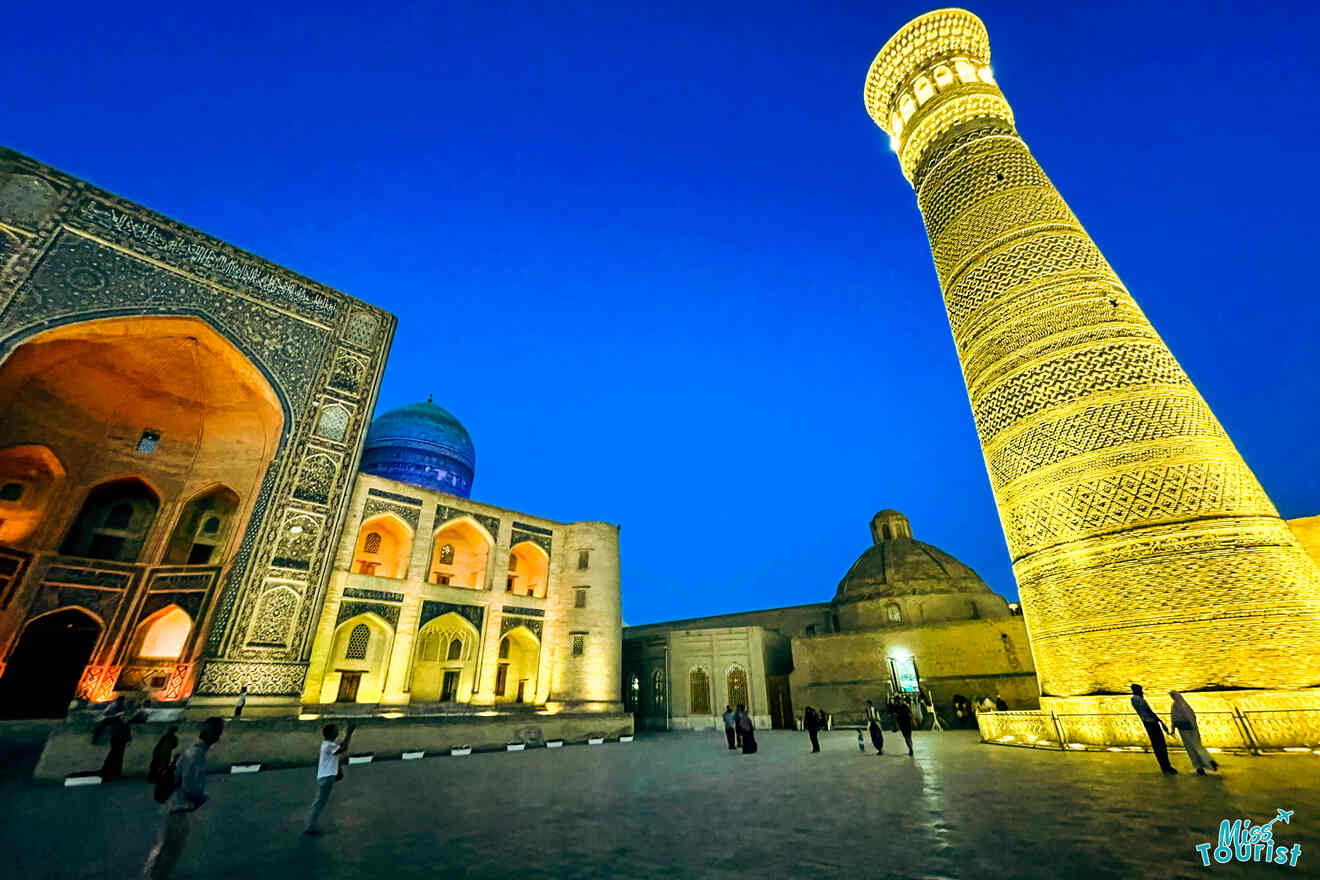
The part I loved about Bukhara is how you can walk everywhere! The more your trip progresses (starting from Tashkent), you’ll be less and less dependent on public transport.
We didn’t use a single bus or taxi ride in Bukhara other than to get to and from the train station. We did once get a quick tuk tuk ride to the Chor Minor madrasa (map) only because it was too hot and we didn’t want to walk for 1 km (0.6 miles).
The main attractions in Bukhara include the gigantic Bukhara Ark (map), a fortress and an archaeological site that was one of my favorite spots in the city. I was in awe of its massive walls. I just kept staring at them, never minding the mid-day heat and the sun!
Then of course, the stunning Kalon Tower (map) or the main landmark of the city, actually part of the Po-i-Kalyan Mosque complex on the central square. You can enter the mosque complex for a small fee (less than $2), but you need to dress modestly.
PRO TIP: Just across the main square you’ll find rooftop cafés and restaurants from where you can enjoy the view of the minaret and surrounding madrasa! I especially recommend you visit during the sunset. The earthy tones of the buildings become golden during the sunset, while the large dome of the madrasa gets illuminated with a dark blue light, a sight you definitely want to experience from above! We watched the sunset off the Minorai-Kalon Hotel’s rooftop terrace (map), and it was phenomenal.
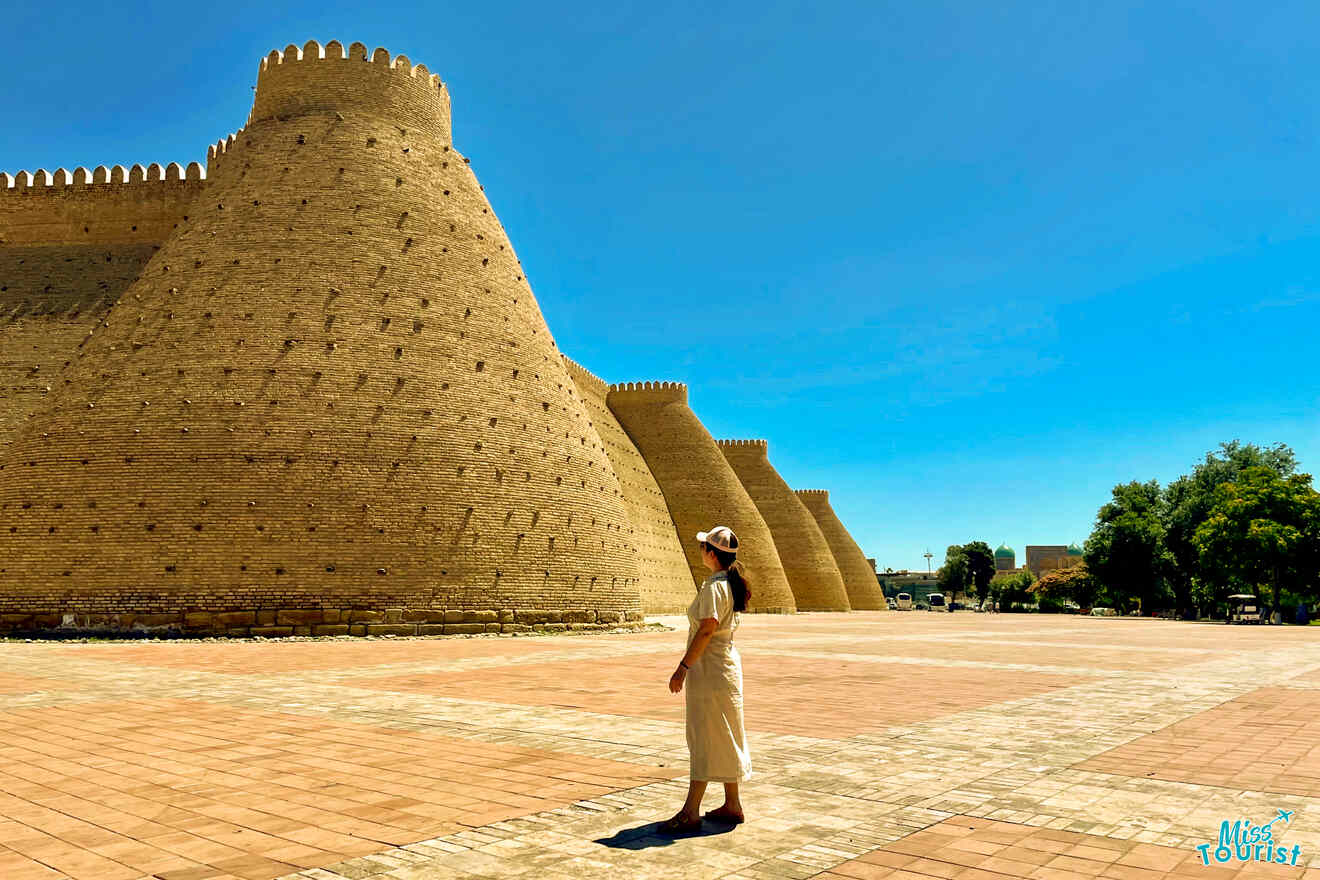
You’ll find plenty of madrasas across Bukhara, but the most popular one must be Ugul’bek Madrasa (map). The madrasa is now a workshop and souvenir shop where local craftsmen sell their products. I bought a lovely silk-woven tote bag here for less than $7, and I now carry it everywhere!
Just across the street from the Ark of Bukhara, you’ll find the Bolo Hauz Mosque (map), one of the most beautiful old mosques I’ve seen.
And then, between the mosque and the Ark is the Bukhara Water Tower with an elevator that takes you to the top for a 360-view of the city. It’s nothing spectacular, but we liked it because it illuminates at night and has these small city plates all around that show the distance to other cities.
You can see how this part of the world really is in the center between Europe and Asia, with Berlin and Beijing both being 4,500 km (2,700 miles) away.
For shopping, make sure not to miss the legendary trading domes (map) from the times of the Silk Road, they’re just steps from all the attractions. I bought various miniature paintings from a local artist here who sells them for like $10, but the attention to detail is insane in his work!
Where to eat in Bukhara
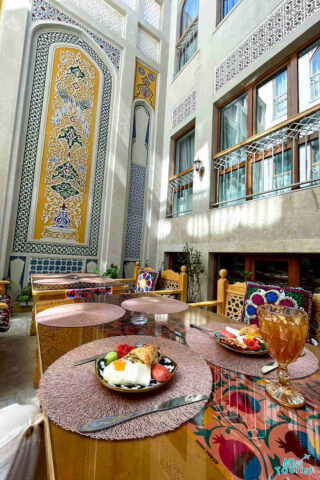
Bukhara has a thriving food scene, we found so many restaurants we wanted to try but had too little time.
The most legendary restaurant you have to try is Old Bukhara (map), it’s like an institution! They have 2-floor seating arrangements in a traditional décor that resembles a small Uzbek house.
There are tons of places at Lyabi Khauze Square (map) serving traditional food as well, plus this really fancy place called Joy Lounge (map) just steps from Lyabi Khauze.
We ate in all three places, and Old Bukhara was our favorite. We had to return for lunch on the last day!
I also must recommend the Silk Road Teahouse (map)! They don’t really serve food, but they have a great offer where you get unlimited tea refills for 70,000 soms (US$5.5) paired with 4 or 5 types of local Oriental sweets. The ambience is so authentic too, you can tell they really took care of every detail.
Where to stay in Bukhara
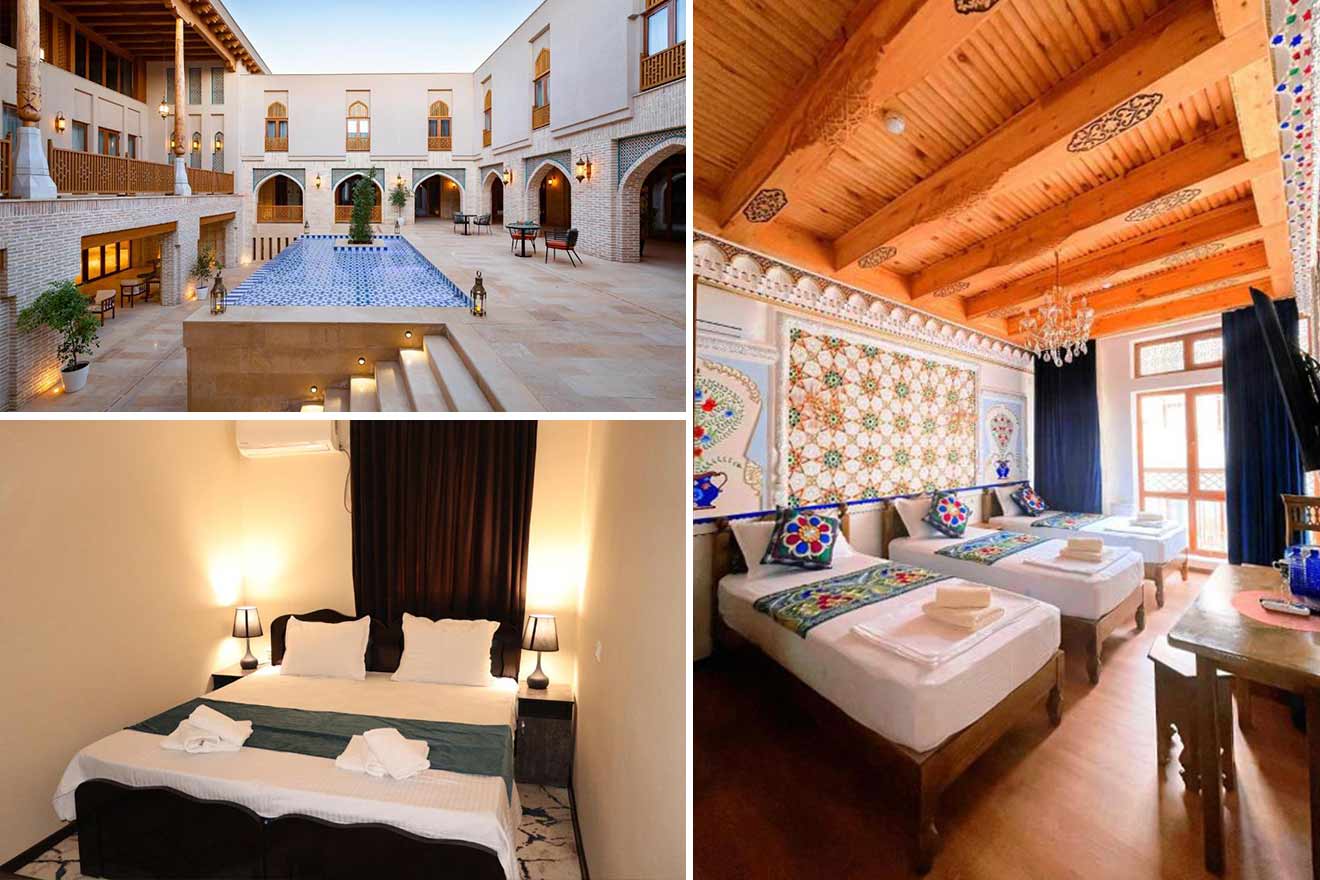
- Luxury (US$80 and up): Mercure Bukhara Old Town – persian architecture and décor with a modern twist – it’s how I could best describe the interior of this 4-star hotel. Elegant, luxurious, and centrally located, it’s the best luxury hotel I could find in Bukhara. They have a pool and hammam that you’ll definitely need if you visit during the hot months!
- Mid-range(US$40 – US$80): Meros Boutique Hotel – this was our hotel in Bukhara and I couldn’t recommend it enough – beautiful, central, family-owned, and perfectly clean
- Budget (up to US$40): Al Bukhari Boutique Hotel – a top-rated budget hotel with a convenient location, dormitory and private rooms, and welcoming staff
Day 5 & 6 – Khiva, open-air museum city
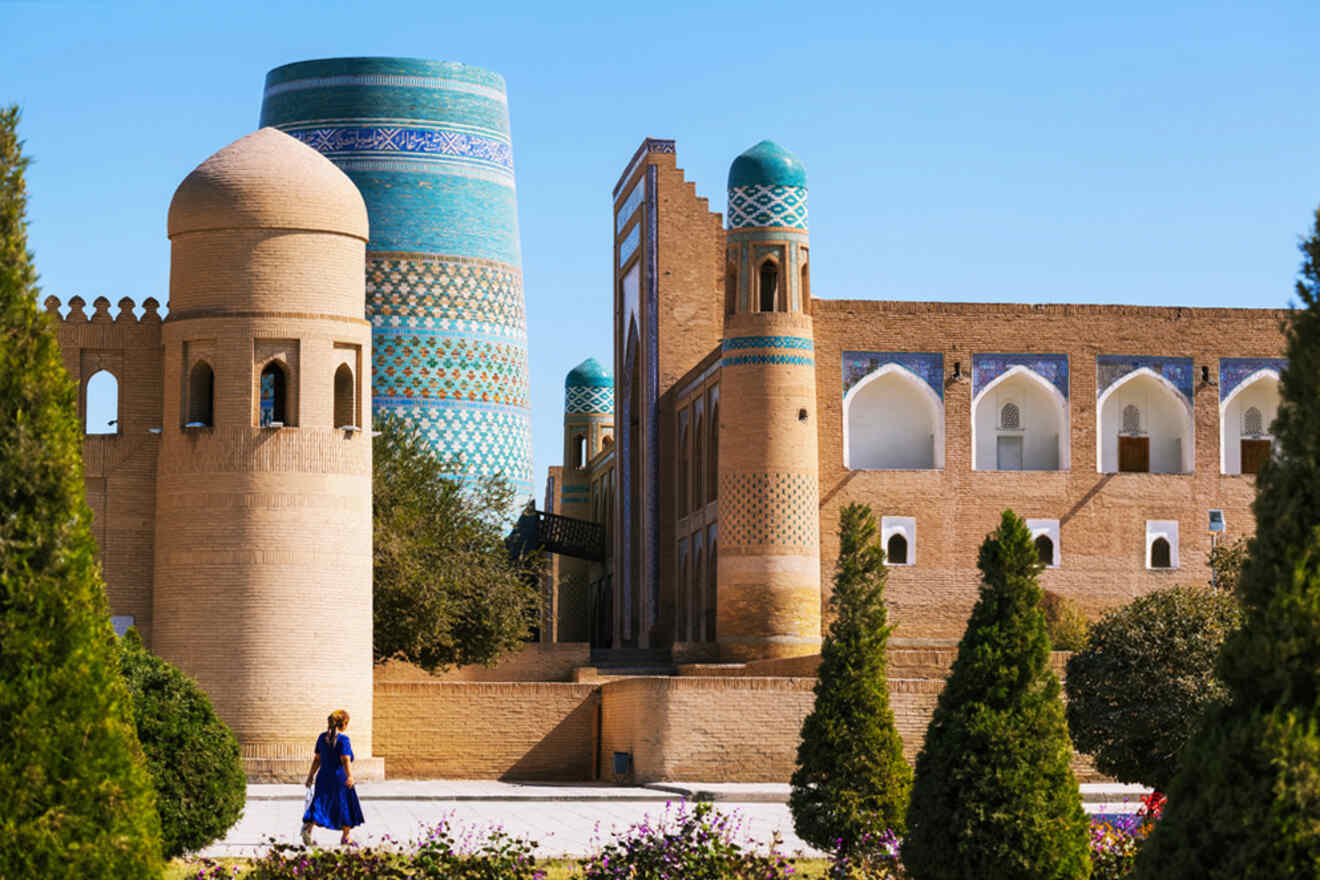
Now here’s the make or break point of every Uzbekistan trip. Khiva is a charming living museum city 450 km (277 miles) Northwest of Bukhara. And Bukhara is already 570 km (354 miles) away from Tashkent. Due to the distance, very few travelers actually make it to Khiva, but those who do all say that this was actually the highlight of their trip.
So I wanted to include Khiva in this itinerary even though I didn’t make it there. I want to encourage you to be in the small percentage of tourists who end up going! I’ll share how to get there in a few moments, but first, I want to tell you what makes Khiva so special!
Khiva is the best-preserved historic city in Uzbekistan, and it’s the most authentic city in terms of historical heritage! Its city walls date back to the 10th century, and inside, you’ll find the most beautiful minaret in all of the country – Kalta-minor Minaret (map) that’s like the soul of the city.
FUN FACT: The Kalta-minor Minaret is actually unfinished. There are numerous theories as for why that is, from the death of the ruler who ordered its construction, to the lack of money, to the engineering challenges that would make the minaret too high and structurally unstable.
How to get to Khiva
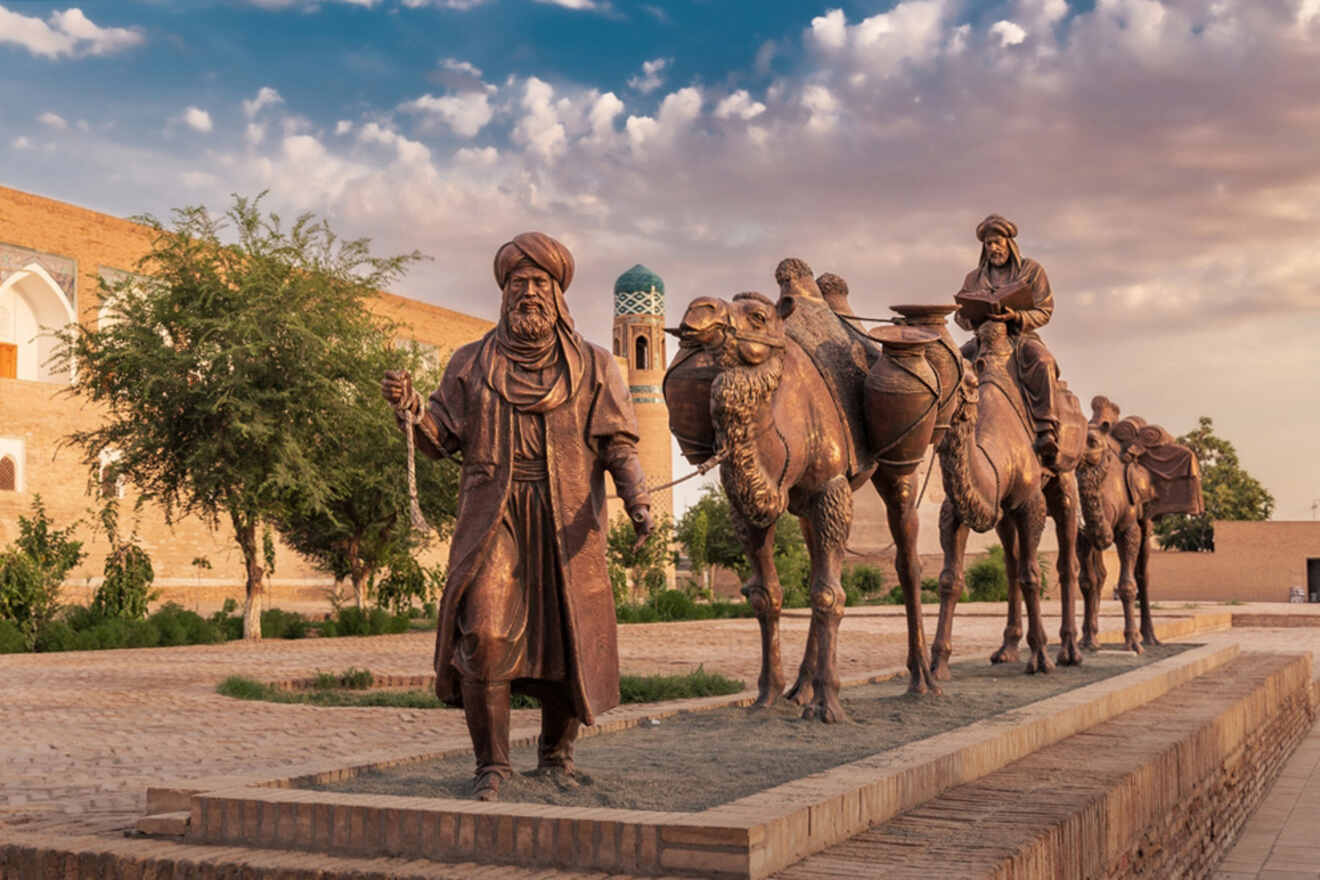
There are 3 ways of getting to Khiva for tourists:
- A train from Bukhara (ride is 6h 30 minutes, continuation of the itinerary above).
- A plane from Tashkent to Urgench, then a bus to Khiva (travel time overall around 5 hours, best if you want to do the itinerary in the opposite direction: Khiva – Bukhara – Samarkand – Tashkent).
- A train from Tashkent to Khiva (least efficient, travel time 16 hours).
The fastest and most efficient route is to take a train from Bukhara, spend 2 days in Khiva, and then fly out from Urgench or Tashkent. If you can find train tickets and plane tickets to match this, I say go for it!
We only planned 5 days for Uzbekistan and unfortunately couldn’t fit a trip to Khiva in the already tight schedule. But if you’re more flexible and can spare 2 more days, it’ll definitely be worth it!
By the way, if you ever wondered whether it makes sense to rent a car in Uzbekistan – it doesn’t. All the cities are so far away you’d be spending most of your days inside a car. I would only recommend renting a car in Tashkent if you’re traveling with kids and want to save time on commute.
Things to do in Khiva
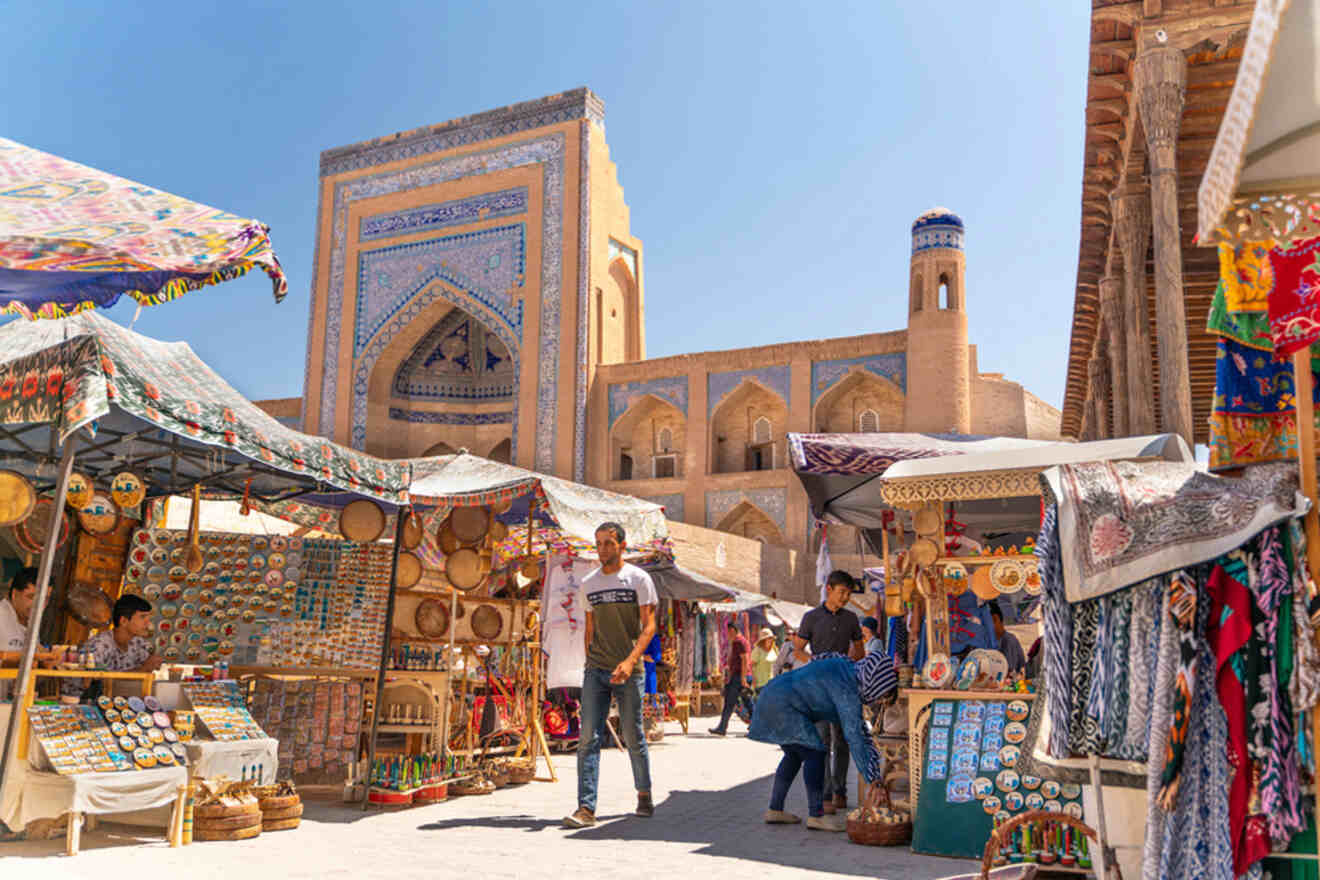
Walk, walk, walk! Khiva is so compact, basically everything you want to see is inside its city walls. A walk from the North to South gate takes around 10 minutes, and most of the mosques and attractions will be on the way.
I’d definitely see as many gates to the Old City as possible. They look amazing, as if they came from another planet with their earthy tones and plain walls.
Apart from the Kalta Minor Minaret I already mentioned, some beautiful sights also include the Juma Mosque (map) and the Islam Hoja Minaret (map).
FUN FACT: The Ichan Khala (map), or the area inside the city walls of Khiva, was the final resting place for Silk Road caravans after which they entered the deserts that led them to Iran (today’s Turkmenistan). So much history here!
Where to eat in Khiva
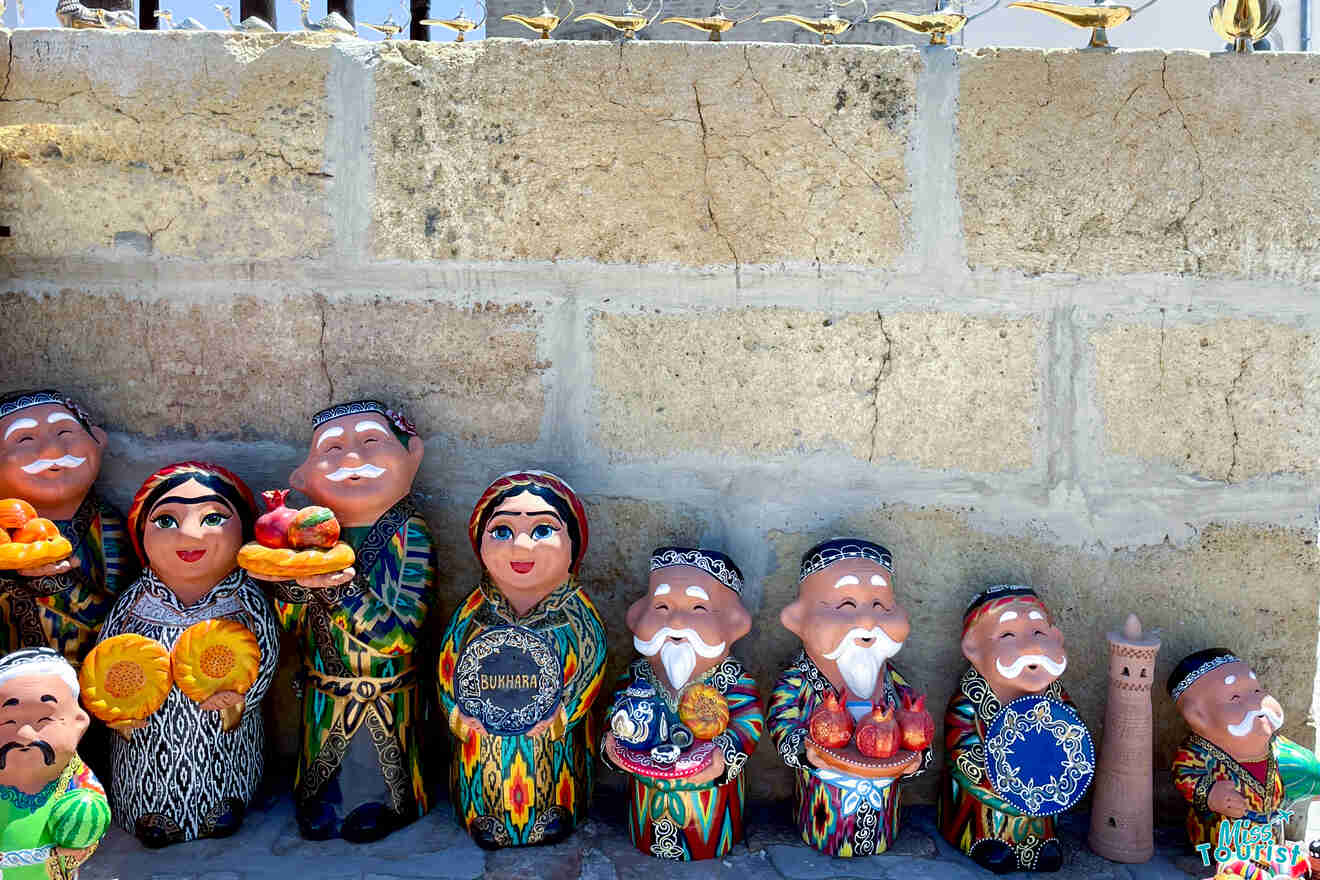
Terrassa Café and Restaurant (map) is definitely the top-rated and, I’d say, most romantic restaurant in town with a charming rooftop terrace. The place can get too crowded since it’s in a touristy area, and they serve mostly modern, international cuisine.
Khiva Moon (map) is another great place just outside of the city walls with delicious plov.
For the authentic experience inside the city walls, I recommend Tea House Mirza Boshi (map).
Where to stay in Khiva
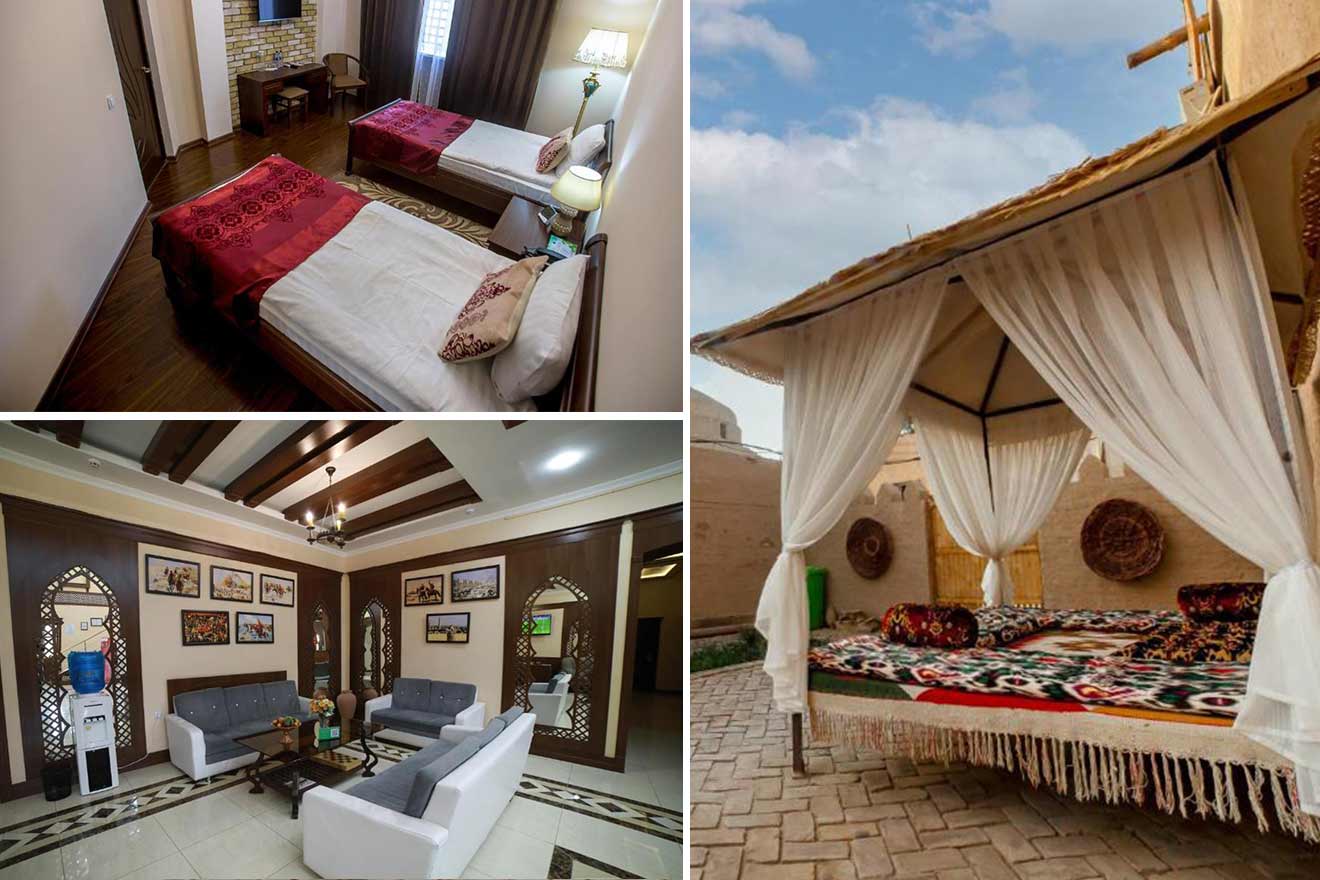
Khiva is known for its historic ambiance, and most of the accommodation here reflects that. There aren’t any 5-star hotels in the city, and the 4-star options I found don’t really fit into “luxury”.
Still, you’ll find a great deal of charming hotels across town!
- Mid-range(US$50 – and up): Arkanchi Hotel – the closest to luxury as it can get in Khiva, a traditional 4-star hotel with wooden décor and stunning rooftop terrace views
- Budget (up to US$50): Islam Khodja – a super authentic stay in the heart of the old town with complimentary breakfast
Day 7 – Urgench / Tashkent (departure)
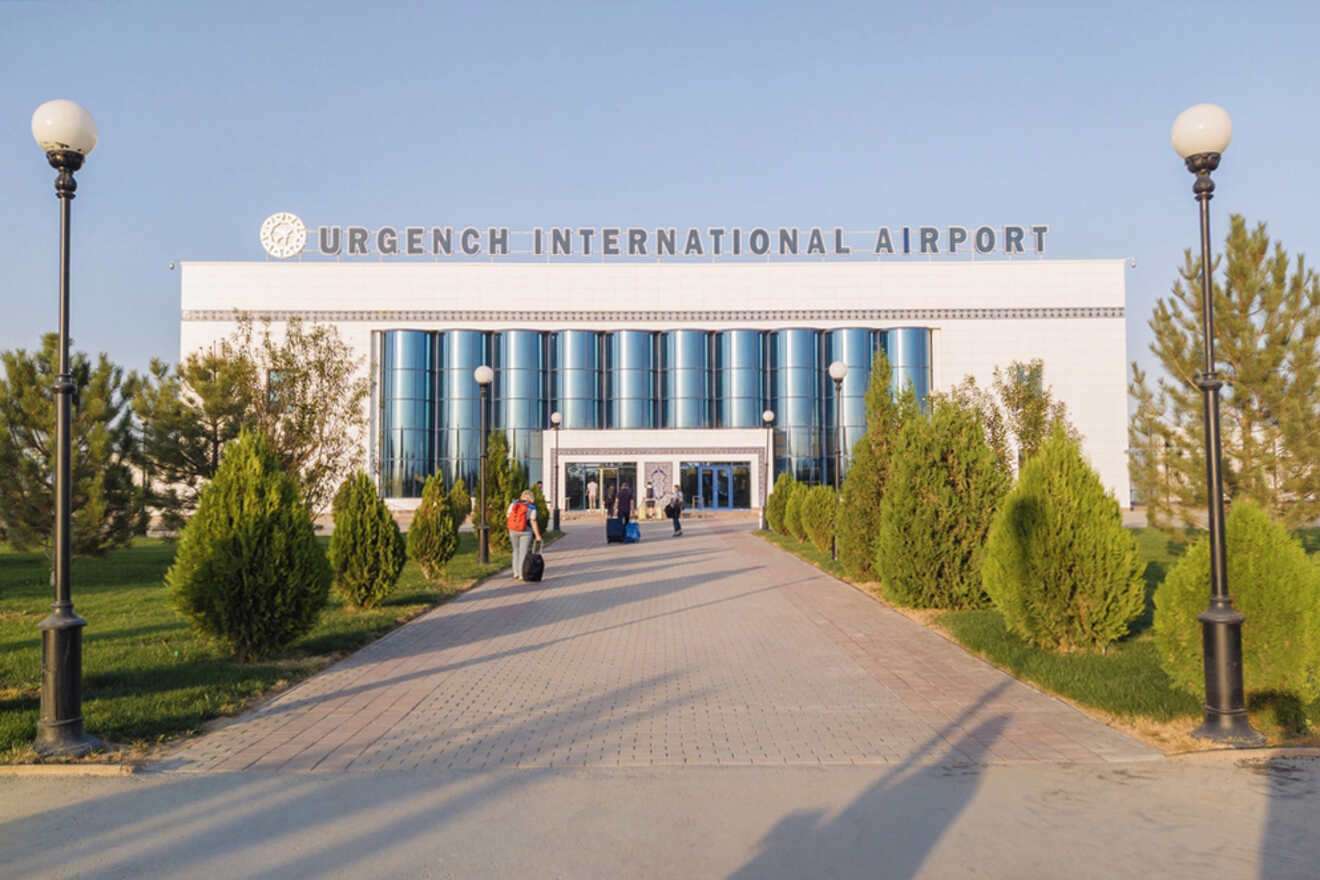
The last day of your 7-day itinerary will mostly be reserved for transport.
Khiva is just a 45-minute taxi ride from the nearest airport in Urgench, but you can also take a trolley bus ride there. The departures are every 30 minutes, and the price is only around 15 cents (1,500 soms).
Uzbekistan Airways has daily flights from Urgench to Tashkent, so be sure to check their website for departure times. If you read the previous part carefully, you remember that it takes at least 5 hours to travel from Khiva to Tashkent on a plane (including a trolley bus or taxi ride to Urgench) and 16 hours if you take the train.
I wholeheartedly recommend a plane instead of a train to get from Urgench to Tashkent. Because who wants to spend 16 hours on a train at the end of their journey?
You can fly out home or to your next destination from Tashkent right away, or spend the night. If the timetable allows it, you can stay in Tashkent for another night for a layover, or fly out the same day. Totally up to you!
Itinerary extension – 10 days
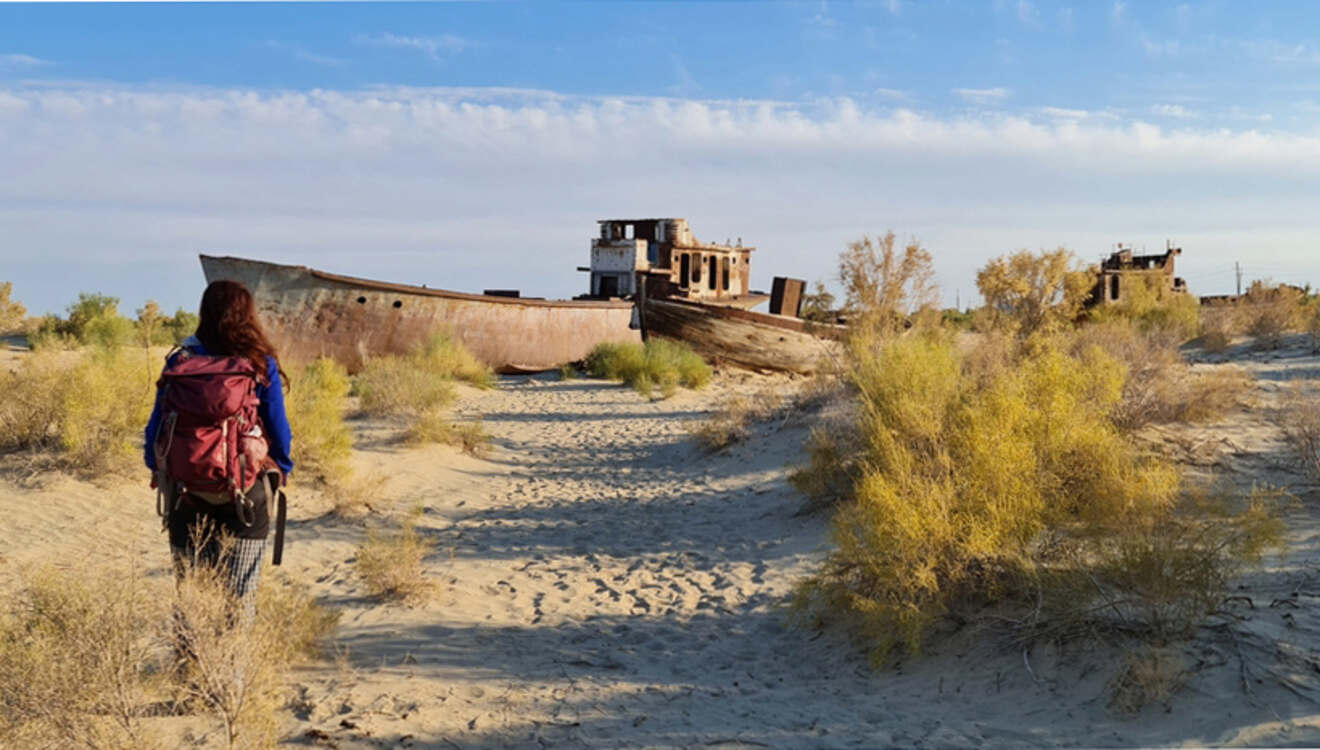
Have more time for Uzbekistan? You can use it to see a few more notable sights!
Day 7 & 8 – Aral Sea day trip from Khiva
Instead of flying back to Tashkent after visiting Khiva, you can take a 2-day tour (journey is long, takes 2 days) to Aral Sea, one of the most unique places in the world.
The Aral Sea used to be a giant lake between Uzbekistan and Kazakhstan that has been shrinking continuously since 1960, to the point where it’s now almost completely dry.
As the cotton industry started developing in Uzbekistan (it’s still the country’s most popular industry), the officials in the Soviet Union diverted much of the river flow away from the Aral Sea to the farms that irrigated cotton fields. This way the lake was left without water, and its levels started to drop.
What used to be the world’s 4th biggest lake is now a desert-like retreat for tourists with sights of rusting shipwrecks and plenty of camping opportunities. It’s not the nicest story, but it’s surely interesting to see, and most of the tourists who feel extra adventurous choose the Aral Sea as their next destination.
They have day trips from Khiva like this one for $230 per group, or 2-day trips like this one.
Day 9 & 10 – Departure
Depending on where you’d be flying out from (Urgench or Tashkent), you may need up to 2 days to travel back home. A 2-day trip to the Aral Sea will bring you back to Khiva, and from there you can depart home following the Day 7 information in the main part of the article (plane from Urgench to Tashkent or a train from Khiva to Tashkent).
| 📅 How many days: | 7-10 |
| 🤩 Best attraction: | Samarkand |
| 🏨 Best hotel: | Hilton Samarkand Regency |
| 🥘 Must-try food: | Plov |
| 🌞 When to visit: | March to mid-June and September to October |
FAQs about Uzbekistan itinerary
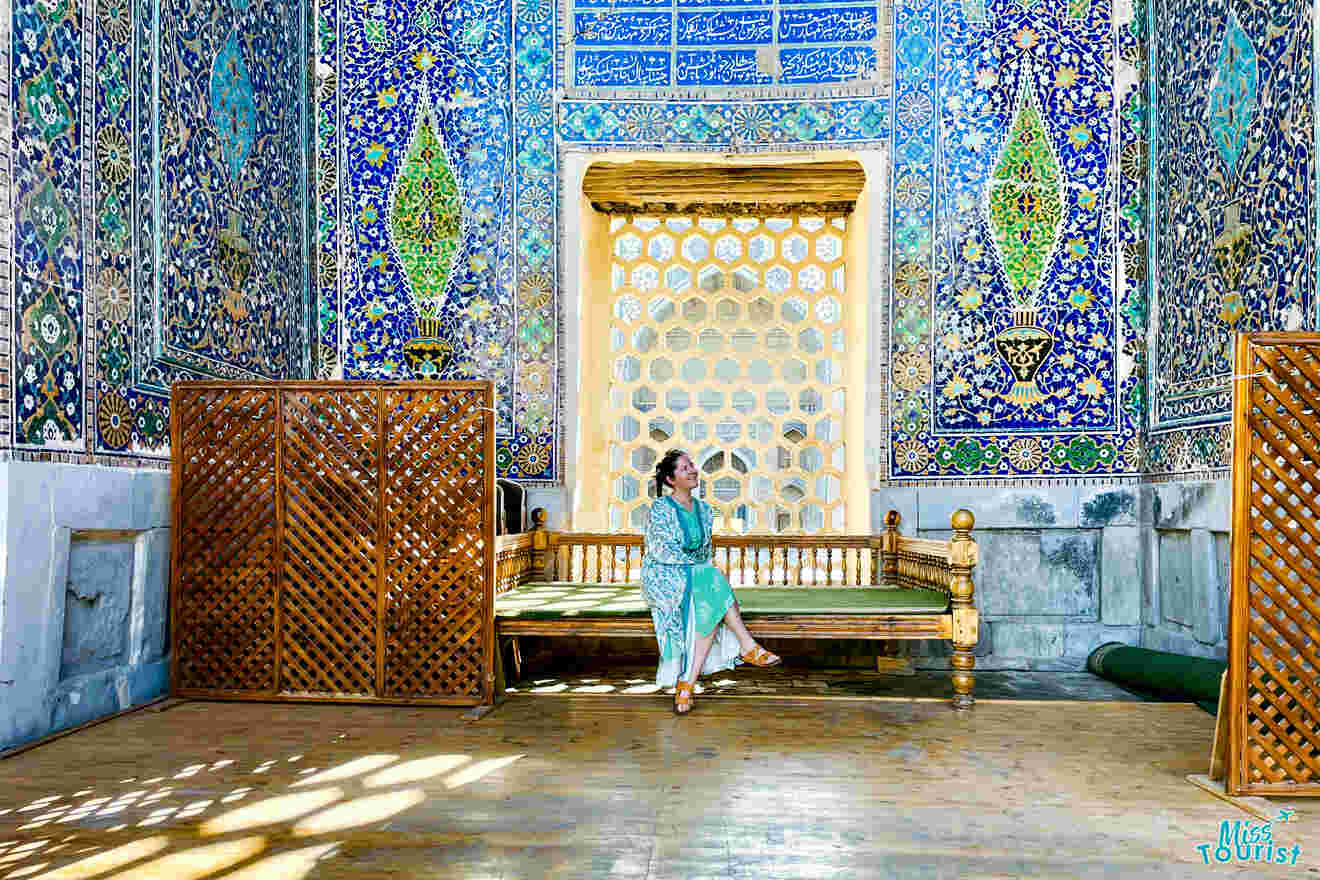
7️⃣ How many days is enough for Uzbekistan?
7 days is just enough time to visit Tashkent, Samarkand, Bukhara, and Khiva, 4 major tourist destinations in Uzbekistan.
🌱 What is the best month to visit Uzbekistan?
March to mid-May is the best time to visit Uzbekistan! We visited at the end of May and it was starting to be unbearable to walk during the midday heat. The temperatures reached 37 degrees already.
✅ How safe is Uzbekistan?
Very! Uzbekistan is a very safe country, and crime against tourists is super rare. You’ll find tourist police in every corner in major tourist spots, too. Exercise usual caution as with any other destination and don’t leave your stuff unattended.
🇺🇿 What are the best things to do in Uzbekistan?
Catch a light show at the Registan Square in Samarkand, go shopping at Chorsu Bazaar in Tashkent, or have a rooftop dinner overlooking the main square in Bukhara.
👍 Is Uzbekistan worth it?
Absolutely! Uzbekistan is one of the most underrated countries in the world (featured in our top underrated countries of the world article). It has plenty of activities to offer to all types of travelers!
🇰🇿 Which is better to visit, Uzbekistan or Kazakhstan?
Both have a special charm. Uzbekistan is more about culture in historic cities while Kazakhstan is about stunning nature and countryside.
Making the most of your Uzbekistan travel itinerary
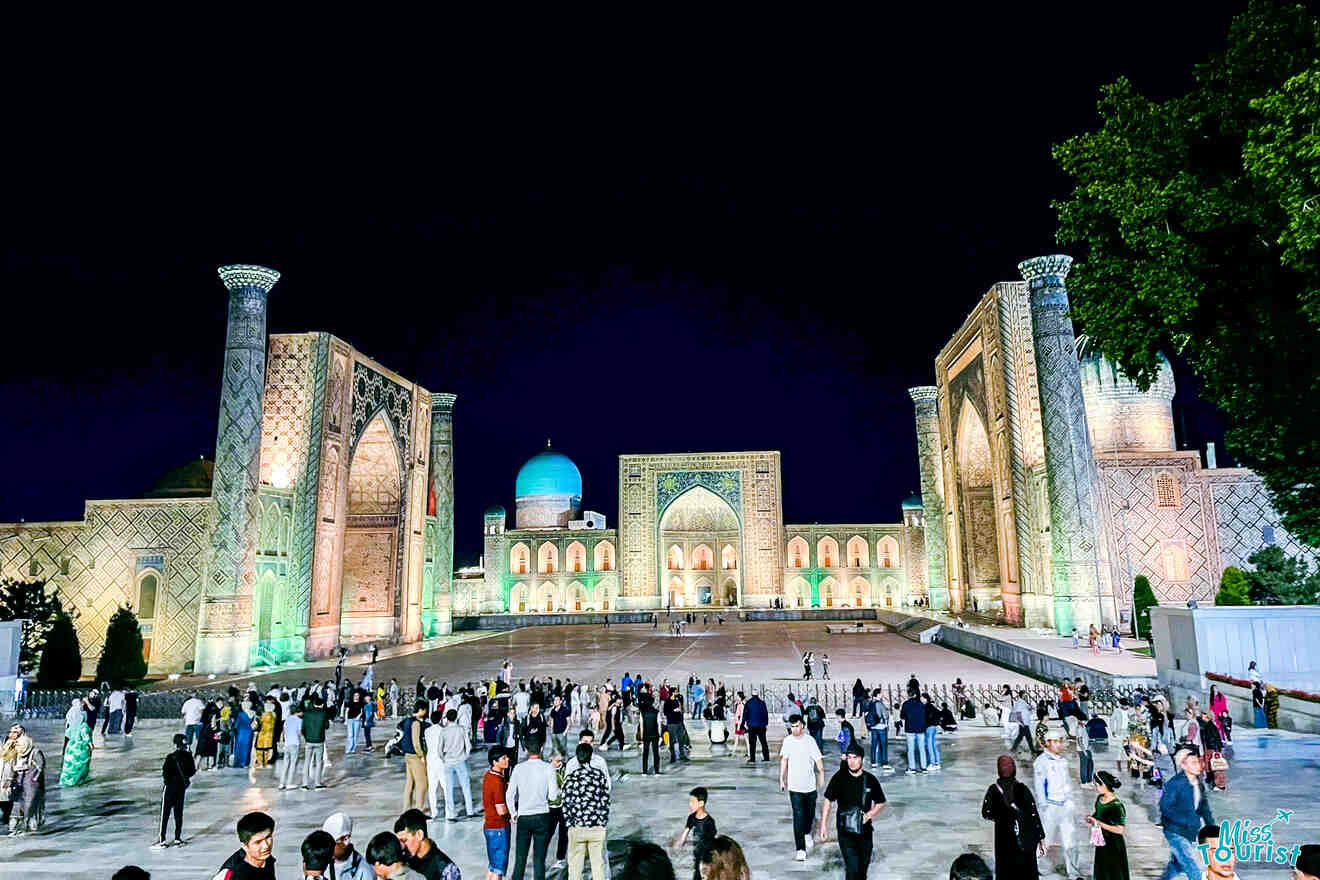
As you reach the end of the article, I want to tell you I’m proud of you! I’m proud of you for choosing to go the path less traveled. My Uzbekistan travel itinerary above is not only filled with cultural treasures, delicious cuisine, and lovely people, but it’s also perfectly safe and affordable!
Much like any other tourist who made it to Uzbekistan, I’m forever grateful for going there as it has helped me see this part of the world with new eyes.
For the end, a friendly reminder to book your train tickets for inside Uzbekistan (more important than everything else that needs booking!!) at least 3 weeks in advance!
I’m determined to help more people discover Uzbekistan, so if you have any questions about your upcoming trip, please leave a comment below!
Enjoy your trip,
Darija
Pin it for later!
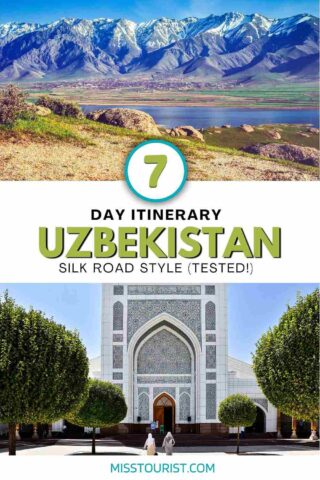
Pin it for later!
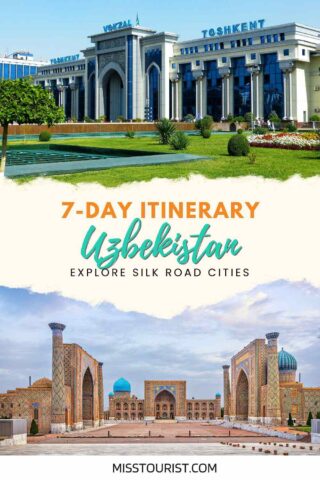

 Darija Stojanovic
Darija Stojanovic 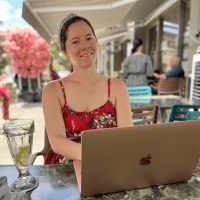




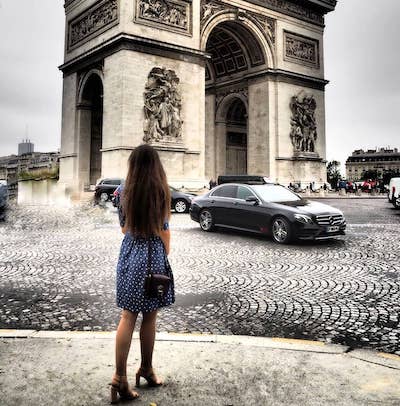

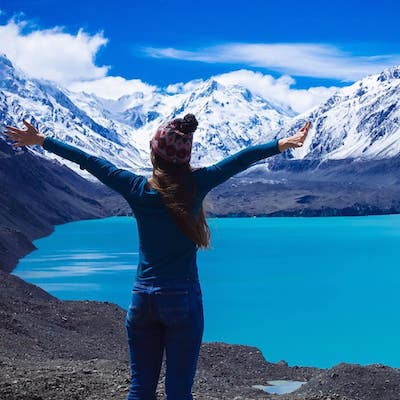
This site is protected by reCAPTCHA and the Google Privacy Policy and Terms of Service apply.